

Long considered to be Earth's twin because of its similar diameter, density, and distance from the Sun, the planet Venus is turning out to be quite different from the image evoked by this analogy. An impenetrable shroud of swirling clouds encircles the planet, while temperatures on the dimly lit surface exceed 750 K. Rains of sulfuric acid fall through a dense, atmosphere of carbon dioxide, and lightning discharges continuously. Today, Venus is a waterless, sterile inferno with no hydrologic system. Its evolution since initial accretion has diverged from the path taken by Earth, a temperate sanctuary for life. Although over twenty spacecraft have examined the planet and its environs, Venus has yielded its secrets slowly. Orbital photographs of the surface of Venus are unobtainable because of its cloud cover (Figure 7.1). Our understanding of Venus is based on radar maps obtained by Pioneer Venus (1978 and 1979), Venera 15 and 16 (1984), Magellan (1990-1995), Venus Express (2006-2014) and Akatsuki (2015). We now know that Venus is an amazing place with abundant volcanoes that are probably active, complex tectonic features, and relatively young terranes with few impact craters. Ultimately, as the clouds are penetrated and the interior probed we will understand how and why Earth and Venus, sisters of the inner solar system, have such different personalities.
A glance at the table of physical and orbital characteristics of Venus shows some of the most obvious reasons for making direct Earth-Venus comparisons. Both are about the same size and density, and are approximately the same distance from the Sun. Presumably, they accreted from similar materials in the early solar nebula and should be similar in chemical composition. Therefore the rates of internal heat generation and the energy to drive volcanism and tectonism should be similar. Further examination of the physical data, however, reveals striking differences between Earth and Venus. For example, the average temperature at the surface of Venus is almost 750 K (hot enough to melt lead) and the atmospheric pressure is 90 times that to which we are accustomed. Venus is almost devoid of water. Thus, the processes of weathering and erosion on Venus are strikingly different than on Mars and Earth. Venus rotates very slowly in the direction opposite that of most of the planets. Moreover, Venus lacks a moon and a measurable magnetic field. Thus, Venus provides an interesting planetary contrast with Earth because, although it is like the Earth in size and density, its surface environment and evolutionary development were dramatically different.
The cloudy atmosphere has kept the surface of Venus completely hidden from view (Figure 7.1), but radar observations from orbiting American and Soviet spacecraft and from Earth-based radio telescopes finally parted the veil of clouds and gave us our first comprehensive glimpse of the surface of our sister planet. The major landforms have been mapped over 98% of the planet's surface. The topographic map derived from radar altimeter data reveals this global view (Figure 7.2).
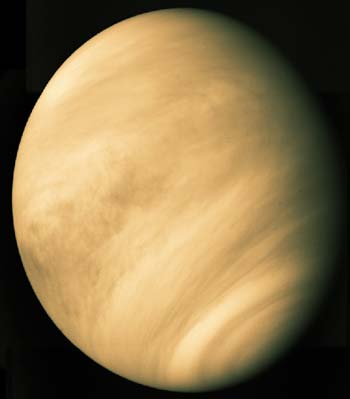
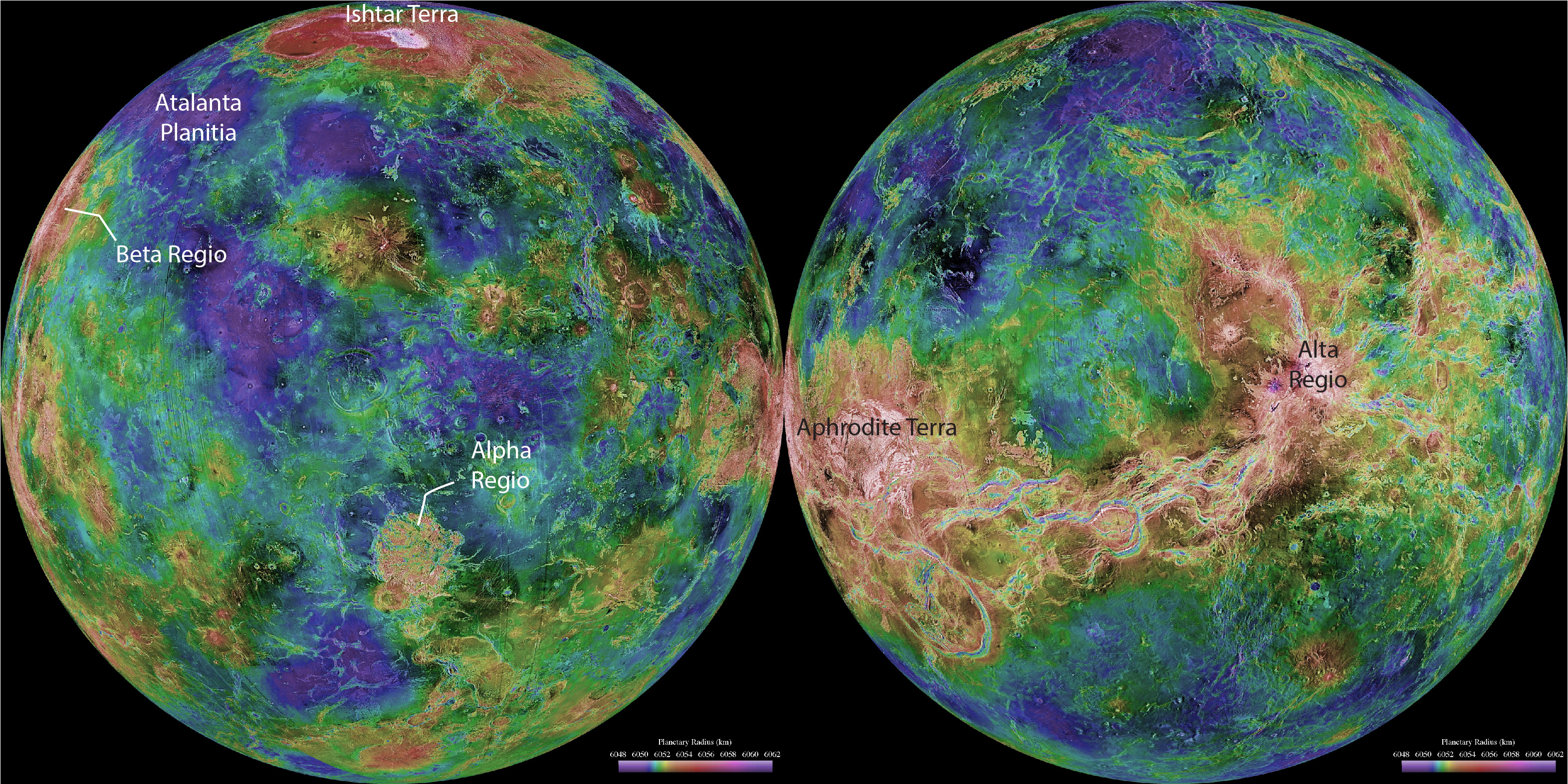
These maps revealed that most of the surface of Venus consists of relatively smooth lowlands with local relief of less than 1000 meters. Two continent-sized highlands and several smaller ones rise above the uplands. These plateaulike highlands are complexly deformed by tectonic processes and have few volcanoes. Large lithospheric domes with abundant volcanic features makeup the uplands with elevations between those of the lowlands and the highlands. Therefore, Venus looks somewhat like Earth drained of its seas, but with larger lowlands and smaller highlands. Moreover, the Venera spacecraft and Earth-based radar studies showed that volcanoes, linear mountain belts, rifts, complexly deformed plateaus, and enigmatic ring structures are present on Venus. Significantly, Venus lacks heavily cratered terrain. With the completion of the Magellan mission, the resolution and coverage of the radar images exceeds that available for much of Earth's solid surface; seventy percent of Earth is covered by oceans. Objects as small as a football stadium are visible in the radar images of Venus. With these magnificent images scientists pieced together the first global view of Venus, but many questions about the potential for active volcanism and tectonism on Venus remain.
The topographic basins show no evidence of being formed by impact and are probably structural basins produced by downward bending of the lithosphere. Some of the most revealing features of the lowland plains are their tectonic features. They are marked by a multitude of strongly deformed zones that are similar in many respects to the mountain belts of Earth (Figure 7.3). Evidence for strong compressional deformation such as found on these lowland plains is unique to Earth and Venus, the two largest planets of the inner solar system.
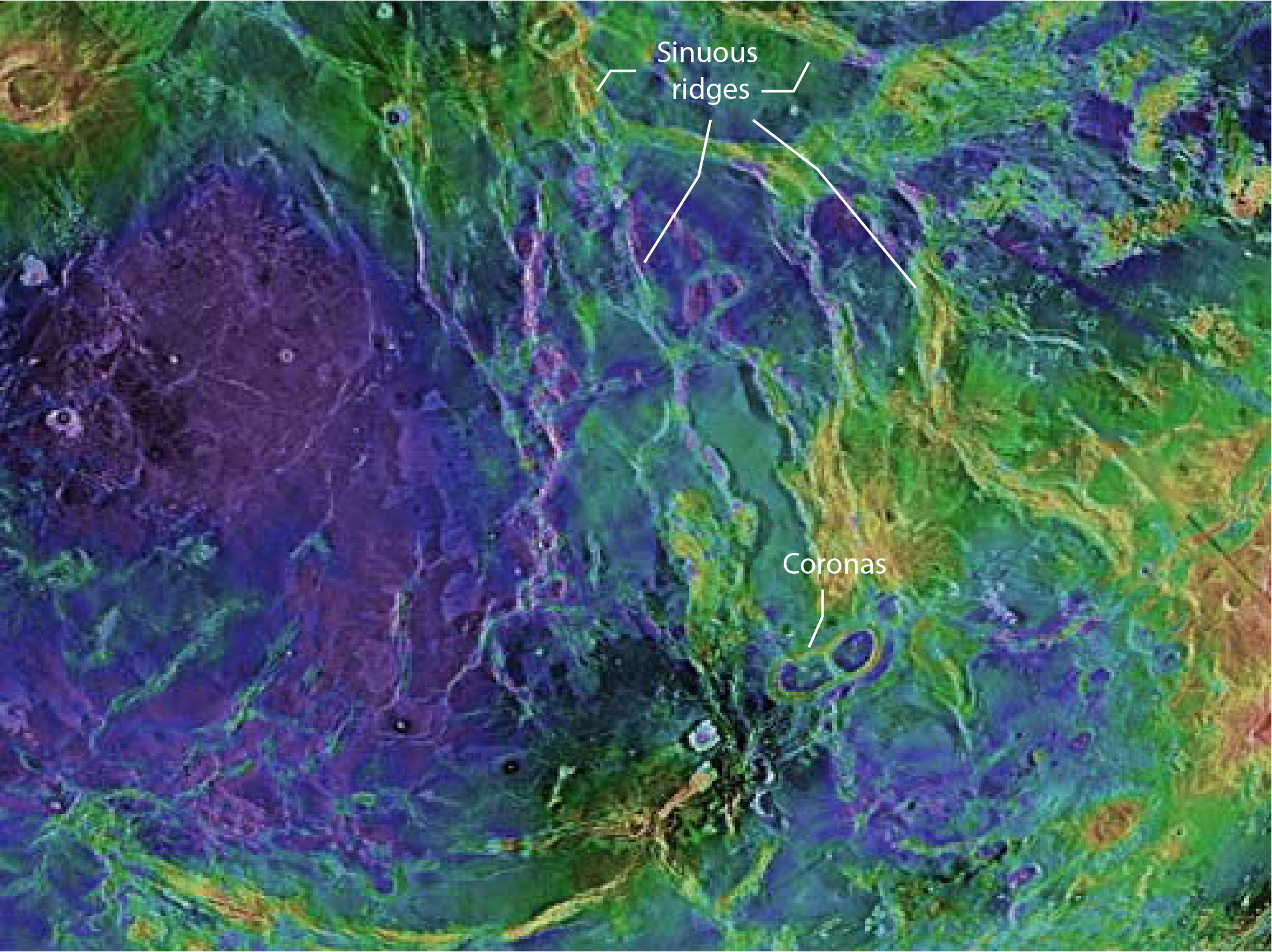
The lowlands of Venus constitute over 60% of the planet and could be called its great plains. These provinces of Venus resemble the ocean basins of Earth, the mare basins on the Moon, or the northern plains of Mars, in that they are low, smooth, and covered in large part by volcanic deposits. Notable for their near absence however, are impact craters. The plains have impact crater densities significantly less than the lunar maria and most of the northern plains of Mars. By analogy with well established lunar cratering rates, the terrain must be quite young (less than a billion years old and perhaps as young as a few hundred million years old). This is evidence that the lowlands (as well as the rest of Venus) were resurfaced one or more times since the period of heavy bombardment. They are much younger than the Moon's maria and most of the martian plains. The relatively young, tectonically modified venusian plains may be more similar to Earth's sea floor than to these other surfaces.
Isolated domes and broad swells rise as uplands above the venusian lowlands (Figure 7.4). The uplands are transitional between the highlands and lowlands, lying between 0 and 2 km in elevation. In contrast to the lowlands, tectonic features are dominantly extensional in character and include long fracture belts, troughs, and rifts. Some rises are broad domes capped by fault-bounded rifts and shield volcanoes. Many volcanoes have summit craters and bright flow features around them. A wide variety of other volcanic features are found on these swells, or volcanic rises. Low-relief calderas, fissure-fed lavas, and central volcanoes are common in the uplands. The ringlike coronas, apparently formed by a combination of volcanic and tectonic processes, are distinctive features common in the uplands (Figure 7.3). Each corona consists of a nearly circular wreath of grabens and horsts. Some coronas are surrounded by flowlike features. Others have collapse calderas, lava channels, clusters of small shield volcanoes, and patches of smooth plains showing the importance of volcanic processes in creating these unique landforms.
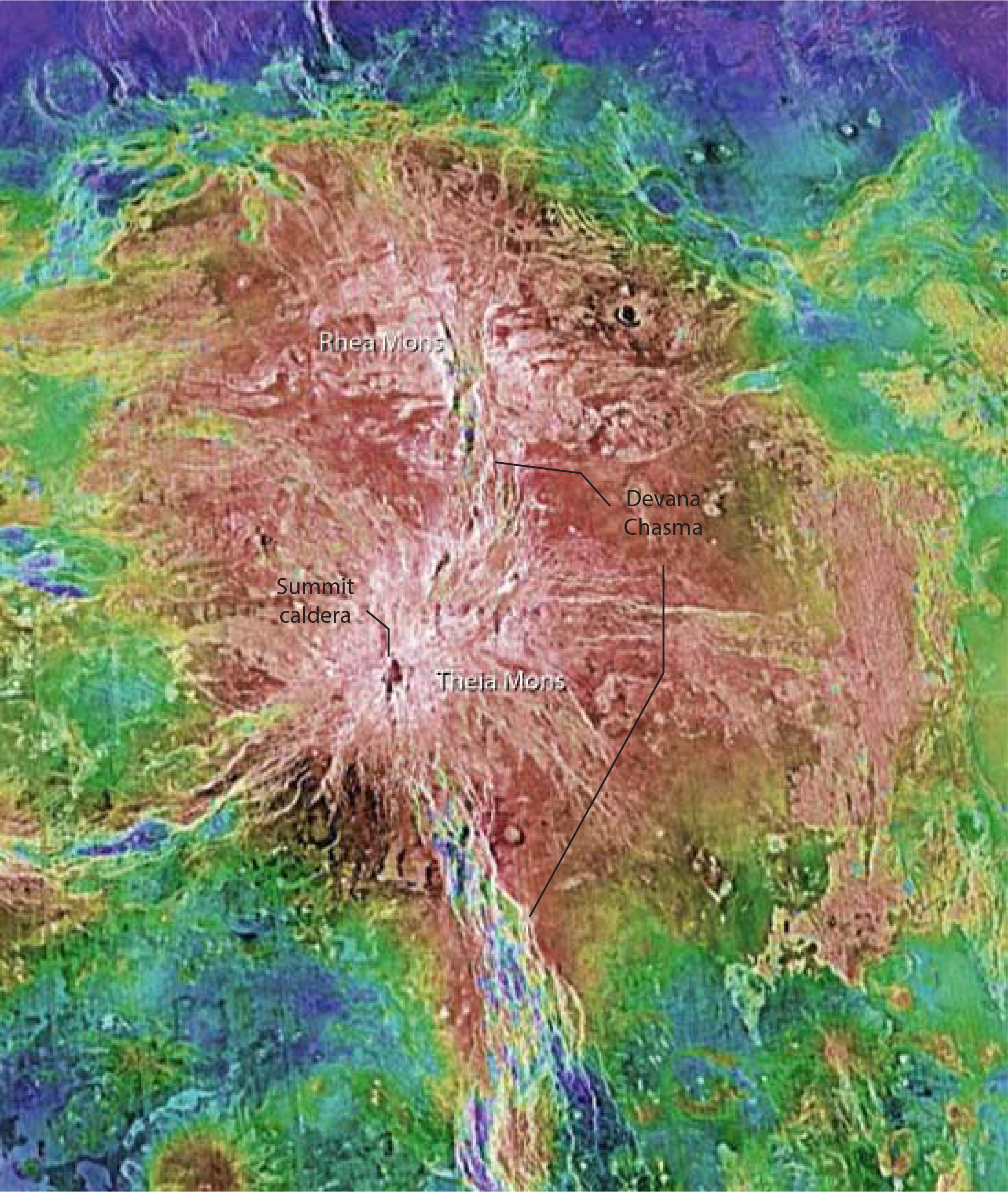
The most prominent of the upland domes is Beta Regio (Figure 7.4). Beta Regio is several thousand of kilometers across and contains a large shield volcano and several coronas. The rift at Beta Regio, called Devana Chasma, is several hundred kilometers long and is flanked by the large shield volcano.
This volcanic rise, and other similar uplands and their rifts, may be the result of tectonic doming and stretching of the lithosphere above upwelling mantle plumes. In many ways, they resemble the lithospheric domes on Mars, Tharsis and Elysium, with their fault-bounded rifts and associated volcanoes, but the venusian features also have some similarity to the rift valleys on Earth, such as the East African rift.
Perhaps the most intriguing features of Venus are the continentlike highlands, which typically stand at elevations of 3 to 5 kilometers (Figure 7.2). The highlands are like plateaus in that they are high but relatively flat and not dome-shaped, like the volcanic rises. Mountainous regions on the plateaus have peaks as high as 11 km; by comparison, the peaks of the Himalayas are about 12 km above Earth's average radius. One highland is surrounded by steep escarpments that resemble the continental slopes on Earth. These highlands cover less than 15% of the venusian surface; in contrast, Earth's continents occupy over 30% of its surface. No samples of rocks from the principal highlands were analyzed by Soviet spacecraft. Direct comparison between the composition and origin of the highlands of Venus and the continents of Earth is still premature. However, from radar studies, we understand something about the sizes, shapes, and surface features of the highlands as well as how they are related to surrounding terrains.
The highest and most spectacular highland region, Ishtar Terra, is in the northern hemisphere (Figure 7.5). It forms a partial arc around the north pole. Ishtar Terra is about the size of Australia, and is wrinkled by large chains of mountainous ridges that include Maxwell Montes, the highest mountains on Venus (Figure 7.5). This rugged mountain belts dominate central Ishtar Terra, rising to an elevation of 11 kilometers. They resemble the mountain belts found on the venusian plains, in that they consist of slightly sinuous valleys and ridges, but they are much higher. These valleys and ridges are interpreted by most geologists to be compressional folds, ridges, and troughs, indicating lateral movement in the lithosphere of Venus. The mountainous terrain of Maxwell Montes is marred by a large 100-km-wide impact crater, Cleopatra crater (~100 km in diameter and 2 to 3 km deep), whose ejecta deposits are not obvious. The valley and ridge mountain belts grade out into lower regions of extremely complex disruption (Figure 7.5) called tesserae (Greek meaning tiles because of the similarity of the texture of these surfaces to a tiled floor). To the west of Maxwell Montes lies Lakshmi Planum, a huge, relatively smooth plateau (Figure 7.5). Rimmed on all sides by rugged linear mountain belts, Lakshmi Planum rises abruptly 3 to 4 km above the plains province. Lakshmi is remarkably smooth and flat, but is broken by two volcanic calderas. These calderas may be the source of the volcanic materials that form the plateau's surface. Small volcanoes are much rarer on Ishtar Terra than on the surrounding uplands.
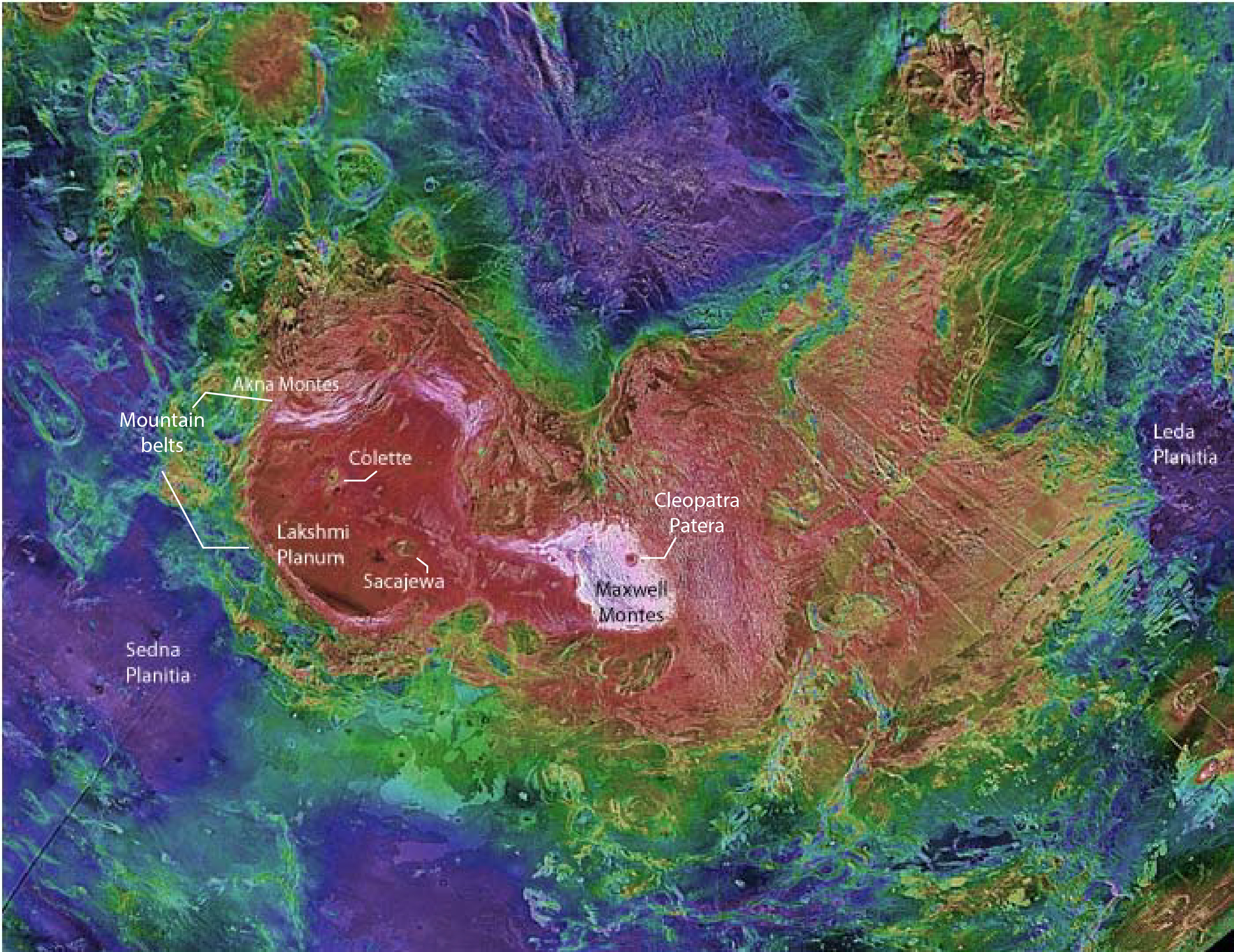
The largest highland on Venus is Aphrodite Terra, named after the Greek goddess of love and beauty (Figure 7.6). It is centered just south of the equator and extends in an east-west direction more than 9500 km. Aphrodite is approximately the size of Africa and is dominated by three plateaus of tessera terrane separated by two saddlelike depressions. One saddle is crossed by deep canyons or troughs (Diana and Dali Chasma). It is also cut by a remarkable arcuate trough (Artemis Chasma) that defines an almost complete circle on Aphrodite's southern borderlands (Figure 7.6). These troughs are probably of tectonic origin. The mountainous plateaus are quite rough with complex ridges and intersecting fractures like other tessera; isolated peaks rise as high as 8000 m above the surrounding low plains. A few large volcanoes dot the eastern plateau of Aphrodite Terra (Atla Regio) including Maat Mons, which reaches an elevation of 9 km, but overall Aphrodite has fewer volcanoes than the adjacent regions.
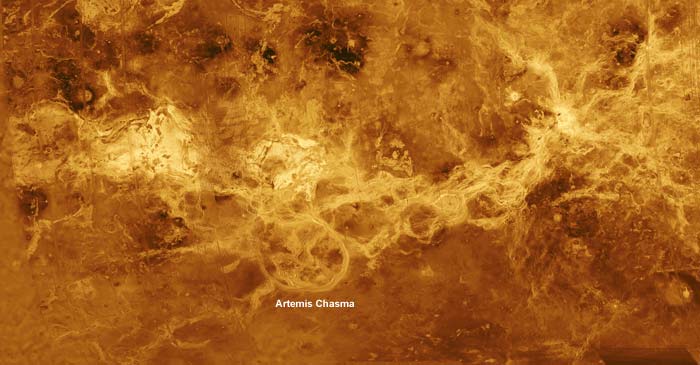
Like the lowlands, tectonic features in the highlands are dominantly compressional. This observation suggests that the highland plateaus are related to extensive crustal thickening over mantle downwelling. It may seem strange to think that downwelling can produce a highland, but downwelling in the mantle could pull crustal material together, piling it up to great thicknesses over a region of downflow. The low density crust thus rises to higher altitudes because it is thicker.
Although no actual photographs of the surface can be obtained from orbit, television pictures taken by Soviet landers provide an entirely different perspective of the surface of Venus. In spite of the dense cloudy atmosphere, there is enough light at the surface to take photographs. In fact, it may be as well lighted as a cloudy day on Earth. Soviet spacecraft landed at four different locations---Venera 9 and 10 (which soft-landed in October 1975) and Venera 13 and 14 (which touched down in March 1982). The landers are all in the uplands region south and east of Beta Regio. Three other Soviet landers also analyzed rocks and assessed the surface environment but had no cameras.
The Venera 9 landing site (Figure 7.7) consists of a field of boulders, some with angular and others with rounded edges. They range from 20 to 70 cm across. Small, darker particles fill the depressions between the boulders. The slabs of rock are layered, and most lie unburied on the surface. The ground beneath the lander slopes away at an angle of about 20°, and the boulders may comprise some sort of talus slope derived by mass-wasting from farther up the slope. The pictures are not clear enough to decide if the slabby layered rocks are impact breccias, lavas, or some type of consolidated sediment; but clearly some dynamic process has fractured, rounded, and possibly moved the rocks. Small particles may be weathering products of boulders emplaced earlier (as impact ejecta or a lava field). Such fine particles could easily be moved by the wind.

The photograph returned by Venera 10 (15.4 °N 291.5 °E) shows an extensive plain composed of patches of varying brightness (Figure 7.8). The lighter material appears to be smooth outcrops and the dark areas may consist of unconsolidated fine particles. A few protrusions are apparent; most of the edges are rounded, possibly the result of a more extensive period of weathering than at the Venera 9 site.

The Venera 13 and 14 landing sites (Figures 7.9 and 7.10), at 7.55 °S 303.7°N and 13°S 310°E are more like the Venera 10 site than that of Venera 9, consisting of smooth surfaces with few pebbles or cobbles. Fine-grained, moderately dark regolith surrounds slabs of lighter-colored rocks at the Venera 13 site. The rocks are fractured and show signs of stratification on a scale of several centimeters. The Venera 14 site appears to have no fine particles. Instead, the surface consists almost entirely of indurated slabs of stratified rocks. Russian scientists interpret this as a volcanic plain where thin sheets of lava created the layered rocks.

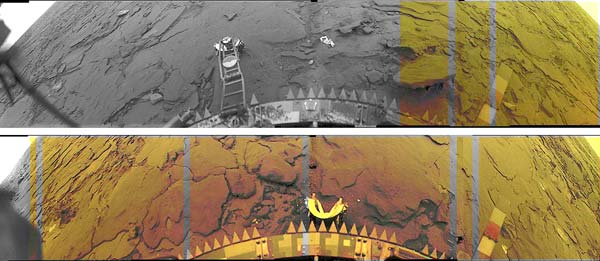
Precise interpretation of this information is not possible. The areas resemble, in some respects, those photographed on Mars, especially the Venera 9 site. They contrast strikingly with the lunar surfaces because of the apparent thinness of the regolith. The surfaces could be composed of lithified eolian sediments or they may be the surfaces of lava flows. However, the pictures clearly show that weathering and erosion have modified the surface materials of Venus. The rocks show evidence of layers, fracturing, and chemical or physical weathering. Transportation of the finer particles by the wind may be the process that exposes the slabby outcrops to the view of the cameras. Thus, some of the same geologic processes we see on Mars and Earth also take place on Venus---with the important exception of hydrologic processes.
Elemental analyses of venusian rocks, performed by instruments on Soviet spacecraft at seven different localities (not all of the landers had cameras), show that they may be similar to terrestrial basalts. Most are similar in composition to basalts erupted from ocean islands or hot spots on Earth. Some analyses show the rocks are rich in potassium, but still similar to other types of terrestrial basalts from the continents and ocean islands. Granitic rocks, like those that form Earth's continents, were not found by these landers, but as discussed below, some volcanoes look as if they were made by eruption of viscous magma. The most common kinds of viscous magmas on Earth are granitic or rhyolitic magmas with high SiO2 contents.
Earth and Venus formed in the same general area of the primordial solar nebula. Therefore, if the composition of nebular condensates depended on their distance form the Sun, it is quite likely that Earth and Venus have similar concentrations of the major elements---iron, magnesium, calcium, silicon, and aluminum. This notion is supported by density measurements determined from the motions of passing spacecraft. The bulk density of Venus (5.24 g/cm3) is only slightly less than that of Earth (5.52 g/cm3).
We have seen that most of the planets and the larger asteroids underwent extensive internal differentiation into layers of different chemical composition and density. In all probability, Venus experienced a similar differentiation process, which produced a metallic core composed predominantly of iron, a mantle of dense iron and magnesium silicates, and a crust of lighter silicate minerals possibly enriched in aluminum, alkalis, and the radioactive elements uranium and thorium (Figure 7.11). As this occurred, volcanic activity released gases (mostly CO2 and H2O), which formed the thick venusian atmosphere. There is, however, little direct evidence for these differentiation events and the nature of the interior of Venus.
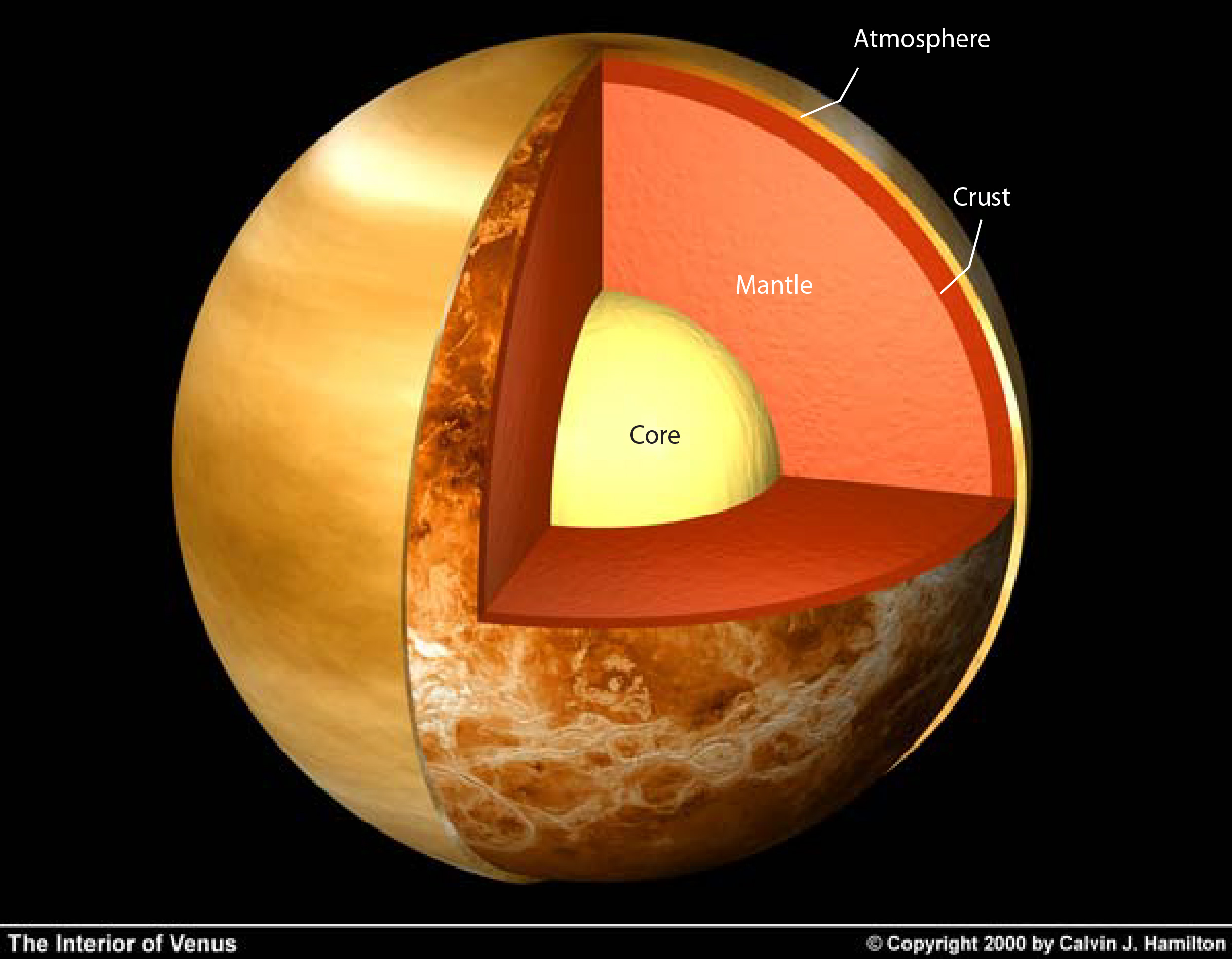
For example, the magnetic field of a planet is probably due to the effect of the planet's rotation on a liquid, metallic core; therefore, the size and strength of this field measured from space probes should tell something about internal structure and temperature. Unfortunately, Venus has no measurable magnetic field. Perhaps, this is because Venus rotates so slowly that it does not produce a significant magnetic field in this way. Thus, the absence of a magnetic field does not preclude the possibility of a liquid metallic core at the center of Venus today.
Beside comparisons with other solar system bodies, there is indirect evidence that Venus is a differentiated planet. Volcanoes and vast volcanic plains prove that internal heating and even melting occurred. The young age of the surface shows that high temperatures within the planet persisted long after the time of heavy bombardment, and may extend to the present. Measurements of the chemical composition of surface materials performed by Venera 8 showed that rocks with high potassium and uranium concentrations may occur on the surface. Although these are only partial analyses, terrestrial rocks with similar high concentrations of these elements (alkali basalts or granites) have experienced extensive chemical differentiation. The more complete analyses returned by Vegas 1 and 2, and Veneras 9, 13, and 14 are similar to basalt found on other planets. These, too, show differentiation of the planet, because basalts are different from primordial meteorite compositions like those that accreted to form the planets. The simplest way to produce basalt is by partial melting of olivine and pyroxene in a mantle, one of the products of differentiation. Linear chains of mountains and deep canyons, discussed shortly, are probably products of lithospheric mobility, driven by substantial convection of the deep interior. Therefore, an internal heat engine must be fueled by radioactive decay. If our interpretations of these surface structures are correct, the interior of Venus has undergone significant internal differentiation.
The atmosphere of Venus is another strong evidence of internal differentiation. It does not have the same composition as the solar nebula gases (H2 and He) and cannot be an inherited atmosphere. Instead, its carbon dioxide-rich character is exactly what is predicted for an atmosphere made by secondary processes of differentiation and outgassing.
Thus, it appears from several independent lines of evidence that Venus must be differentiated. The thicknesses of the differentiated layers within Venus are not known. Venus has a slightly smaller radius than Earth has and a lower density. Perhaps the dense core of Venus is not as large relative to the rest of the planet as Earth's (or Mercury's, for that matter). Some estimate that the core would contain 25% of the mass of Venus (33% of Earth's mass lies in its core). One theoretical model for the internal structure of Venus is shown in Figure 7.11.
One surprising result of studying the interior of Venus is that it may be substantially different from Earth. Examination of the variations in the planet's gravity field suggest, but do not demand, that Venus lacks a shallow asthenosphere like Earth. Earth's asthenosphere permits the lithosphere to move separately from the underlying mantle. As noted in the last chapter, deep mantle circulation on Earth may be dominated by the movement of mantle plumes, whereas convection in the shallow mantle is the result of the independent movement of slabs of lithosphere. If Venus lacks an asthenosphere, then flow in the deep mantle may be directly reflected in the surface features of the planet.

The thickness of the mechanically strong lithosphere of Venus is also unknown, but it is important to realize that even the surface of the lithosphere can deform and flow, by solid-state creep, at the temperatures measured on Venus. The temperature is a significant fraction of the melting temperature of many silicate minerals. At such high temperatures the mechanical strength of rocks is dramatically reduced and they may experience viscous flow (a process like the flow of glacial ice or viscous mud) to reduce the elevation of high scarps or mountains (Figure 7.12). One set of calculations suggests that the topography of large features such as volcanoes or impact basins would be completely erased after a billion years or so. We can conclude from the presence of high elevations on Venus (for example, Ishtar Terra---mountains up to 12 km high---or Beta Regio---4 km high) that either these calculations are incorrect or that many of the landforms of Venus were produced relatively recently.
Venus is totally enshrouded by clouds that extend vertically for more than 50 km (Figure 7.1); as a result, the atmosphere superficially resembles Earth's. Yet, the atmospheric temperature, pressure, and composition of the "twin" planets are strikingly different. Because of the continuous global cloud cover and runaway greenhouse effect, surface temperatures on Venus approach 750 K. As a result of these high temperatures, which would vaporize water, and the inherent lack of water, even as a vapor, in the atmosphere today, there is no hydrologic system on Venus. The mass of water vapor in the atmosphere of Venus is nearly 100,000 times less than in Earth's fluid envelope. Atmospheric pressure at the surface of Venus is 90 times that found at the surface of Earth. At high altitudes, like the top of Maxwell Montes, the pressure drops to less than 50 bars and the temperature to about 650 K. Studies of the spectral characteristics of light reflected from Venus to Earth told us much about the composition of the atmosphere and more sensitive analyses of the atmosphere also were performed by spacecraft passing through the atmosphere. Most of the atmosphere consists of carbon dioxide and nitrogen comprises most of the rest. So far, these studies identified carbon dioxide (CO2, 96.4%), carbon monoxide (CO, 30 ppm), nitrogen (N2, 3.5%), water vapor (H2O, 100 ppm), hydrogen sulfide (H2S, 2ppm), sulfur dioxide (SO2, 185 ppm), oxygen (O2) hydrogen chloride (HCl), and hydrogen fluoride (HF). The contrast with the much cooler, thinner, nitrogen-, oxygen-, and water-rich atmosphere of Earth is striking.
The explanation for the extremely high surface temperatures on Venus is attributed to the greenhouse effect. The nearly transparent atmospheres of Earth and Mars allow much of the heat received from the Sun to escape, by being reflected or reradiated into space. But on Venus, carbon dioxide and sulfuric acid in the atmosphere absorb much of this reflected energy. The energy is eventually reemitted but not until the surface is much warmer than it would be in the absence of CO2. In essence, Venus is like a well-insulated house in the winter. This planetary greenhouse entraps heat received from the Sun and distributes it planetwide so there are no cold polar zones as on Earth and Mars (Figure 7.13). The temperature anomaly is particularly striking because due to Venus's reflective cloud cover, the surface of Venus actually receives less solar energy directly from the Sun than Earth does.
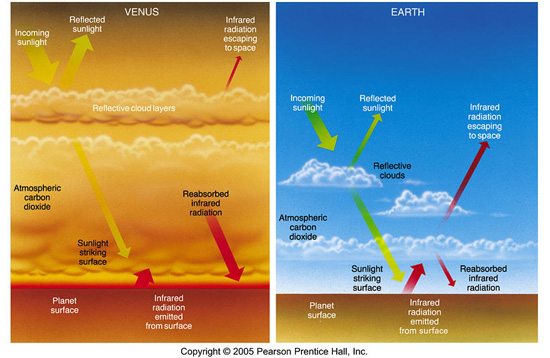
The clouds of Venus are not composed of water vapor or ice crystals, as on Earth, but are probably made of micron-sized droplets of sulfuric acid (H2SO4). The main deck of venusian clouds lies at altitudes between 45 and 75 km, because this is the level at which sulfuric acid can condense because of low temperatures. This potent acid drizzle does not result in the weathering of rocks, because the sulfuric acid rain evaporates at an altitude of about 30 km above the surface. Although the clouds obscure the venusian surface, they are quite tenuous, and visibility within them is several kilometers. It is the thickness, not the density, of the cloud layer that hides the surface. Thin hazes occur both above and below the main cloud deck. Lightning discharges crackle through the venusian atmosphere, but they appear to originate below the main cloud deck, unlike terrestrial lightning.
Differences in the compositions of the atmospheres of Earth and Venus, especially regarding water and carbon dioxide content, are probably due to several factors, foremost among which may be the greater distance of Earth from the Sun. The factor may bear on both the water-poor and carbon dioxide-rich character of the venusian atmosphere. Some nebular condensation models suggest that Venus and Earth had similar amounts of water and carbon dioxide. The differences could be explained as follows. Earth may have been just enough cooler than Venus to allow water vapor to condense to a liquid, rain out of the atmosphere, and collect into oceans and lakes. In these bodies of water, Earth life began to evolve before three billion years ago. Even primitive plants must have consumed carbon dioxide from the atmosphere, using the carbon to build organic molecules and releasing the oxygen gas as a waste product. In this way, the oxygen content of the atmosphere on Earth was gradually built up. On the other hand, much of the carbon from the atmosphere remained in the biosphere as organic solids. Photosynthesis alone may not have removed much carbon dioxide from the air; but as the oceans and life continued to evolve, carbonate minerals---calcite (CaCO3) or dolomite (MgCa(CO3)2)---began to crystallize from Earth's oceans to form layers of limestone rock on the sea floors. Some types of ancient plants help to extract calcite from sea water. In addition, organisms with carbonate shells eventually appeared. When the organisms died, their shells accumulated on Earth's sea floor and, together with carbonate minerals precipitated directly from the oceans, formed limestone. As a result of the removal of carbon dioxide from the atmosphere and the ocean, Earth's crust contains great deposits of carbonate rock---mountains of rock, which could be considered Earth's "fossilized" atmosphere. If all the carbon dioxide could be released from terrestrial carbonate rocks, the atmosphere of Earth would be similar in composition to that of Venus and about half as dense. Even if carbonate minerals formed on Venus in the distant past, temperatures now are high enough to break down these minerals and release the carbon dioxide to the atmosphere again.
The apparent lack of water on Venus is more puzzling than its thick atmosphere of carbon dioxide. Obviously missing are features produced by the circulation of water through the atmosphere and on the surface of Venus. River valleys, oceans, groundwater, glaciers, and ice caps---all important elements of change on Earth and Mars---are not apparent in radar images of Venus. At least three explanations for the absence of water-related features need to be considered.
The first explanation assumes that Venus did not accrete materials with the same amount of water-forming elements. Some models of the temperature gradient in the primeval solar nebula predict that minerals containing water did not form until well past the orbit of Venus (or Earth for that matter). If hydrated phases did not condense near Venus, neither could they be accreted into planetesimals that formed the planet nor later outgassed.
The second explanation relies on the loss of water after outgassing. In this model of planetary evolution, both Earth and Venus started with similar contents of volatile elements. This could be true if the volatiles were added to the planets by late impacts of volatile-rich materials that condensed farther from the Sun than either Venus or Earth did. Some speculated that the inner planets received a substantial part of their volatile endowment when they were peppered by comets late in their accretion histories (Chapter 2). But, because it is closer to the Sun, Venus may have been warm enough to keep all of its water in a gaseous state. Moreover, under proper conditions of pressure and temperature, ultraviolet radiation from the Sun may break the hydrogen-oxygen bonds in molecules of water vapor. The light hydrogen may then leave the atmosphere and escape into space. Thus, the atmosphere of Venus may have been desiccated. If this happened, the oxygen either escaped to space as well or combined chemically with surface rocks; if not, the oxygen content of the atmosphere of Venus would be much higher than observed. In fact, the reddish color of the surface of Venus as seen through the eyes of the landers suggests that it is oxidized. Measurements of the isotopic compositions of hydrogen in the venusian atmosphere are consistent with this notion and suggest that the equivalent of a shallow venusian ocean may have been lost over the course of geologic time.
The third alternative for the history of water on Venus is much like the second but allows for the possibility that liquid water existed on the surface of a pregreenhouse Venus. If temperatures were low enough, outgassed water vapor may have condensed as a liquid and shaped surface features for a time during the early history of Venus. Some time later, greenhouse heating vaporized the liquid water, driving it into the atmosphere, where water molecules could be disrupted and the hydrogen lost into space. Perhaps ancient water-related features were destroyed by the active volcanic and tectonic processes on Venus, because no evidence has yet been found for an early hydrologic system on the planet. Future studies of Venus may be able to tell us which of these alternatives is correct.
The lack of water on the surface has important implications for the evolution of Venus. The important role of water and ice in shaping the surface of Earth cannot be understated. Movement of water occurs continually through an extensive, well-integrated system of oceans, rivers, lakes, and glaciers to produce an endless variety of landforms and rock types. Many common rocks on Earth---shales, sandstones, and limestones---owe their existence to some portion of the hydrologic system. Water and ice were also important in shaping the geologic evolution of Mars, as evidenced by the rampart craters, ancient streams, and huge channels produced by catastrophic floods. However, Venus lacks these surface features and rocks produced by water. No evidence of ancient water-related landforms has yet been found on Venus within the limits of resolution on the available radar images. At present, Venus is far too hot for water to exist either as a liquid or a solid, so water cannot now be a major geologic agent there.
The lack of water may be critically important to other aspects of planetary development as well. A small fraction of a percent of water in a planet's mantle can lower melting temperatures by 200 K, make the mantle fluid at lower temperatures, and consequently aid development of an asthenosphere at shallow depth. A weak, lubricating asthenosphere is vital for the lateral movement of large plates of lithosphere. A brief statement of this idea is--no water, no asthenosphere; no asthenosphere, no plate tectonics. The generation of light granitic magma (rich in silicon and poor in iron, magnesium, and calcium) by extracting a partial melt from rocks initially more rich in iron, magnesium, and calcium, also seems to require that melting take place in the presence of some water. Dry melting of silicates produces less silica-rich magmas. From these facts, some have inferred that the production of light granitic magma is prohibited inside dry Venus, thus prohibiting the development of Earthlike continents---no water, no granite; no granite, no continents.
Some of the most important future observations may clarify the role water has played in the history of Venus. If liquid water (which can exist to a temperature of almost 570 K at the present atmospheric pressure) at one time existed before greenhouse heating, why aren't water-related features preserved? Has Venus always been devoid of liquid water as a consequence of condensation near the Sun? If not, how did Venus lose its water? Is there granite on Venus? Does the lack of water make a shallow asthenosphere impossible? The answers to these questions will be important in determining the nature of the materials in Venus.
An atmosphere is also surface fluid and, its movement as the wind, plays an important role in the geologic evolution of surface features on several planets and moons. The nature a planet's atmosphere helps determine, among other things, the surface temperature, the type of weathering or sediment cementation, the kind of hydrologic system, and the character of the eolian regime. Certainly the atmosphere of Venus, with its host of strong acids, high temperatures, and high pressures has played an important role in the evolution of surface features and the types of rock exposed and produced at the surface, but is the wind also an important agent of change?
The Soviet landers photographed loose soil that could be a source of particles small enough to be moved by the wind. They also revealed bare rock surfaces swept clean of fragmental debris, perhaps by the wind. More conclusively, sequential television images taken by the Venera landers show that particles move on the surface. Other images show accumulations of particles in wind shadows behind rocks. Other affects of the dense, soupy atmosphere on eolian processes are likely to be significant. The wind-related landforms produced under high atmospheric pressure (90,000 mb; an equivalent pressure occurs in terrestrial oceans at a depth of about 1 km) could be quite different from those produced from Earth's moderate atmospheric pressure (1000 mb) or from Mars's light pressure (10 mb)
Direct measurements at the surface by Venera spacecraft show that, although generally low, wind velocities (1 to 36 km/h) are high enough to move small particles like sand and dust. Because the atmosphere is so dense, it can transfer kinetic energy from flowing gas to solid particles more easily than can a thin atmosphere like the one on Earth. Only one-tenth of the wind velocity necessary to start sand grains bouncing and moving on Earth is required to start eolian transportation on Venus. Impact processes may also produce massive, but temporary wind storms the transport particles on Venus.
Thus, it was with great anticipation that the first high-resolution images returned by the Magellan spacecraft were searched for any evidence of wind activity on Venus. A host of landforms were found (Figure 7.14). Although no global dust storms were discovered on Venus, many of its eolian landforms are like those on Mars. The wind has created streaks, dunes, and the erosional features called yardangs. Wind streaks are the most common and are found at all latitudes and elevations, demonstrating that eolian processes operate widely on Venus.
Streaks. The most obvious eolian features on Venus are groups of parallel plumes or streaks (Figure 7.14). The streaks can be as much as 100 km long and they can be bright or dark. Streaks commonly originate at topographic obstacles that acted as wind shadows or to enhance wind turbulence and hence scouring of the area immediately behind the obstacle. On Venus, ridges, tectonic hills, volcanic cones or shields, and impact craters all act as obstacles to the flow of the wind and many have wind streaks behind them. In fact, several thousand streaks were identified over the 40% of the surface that was examined in 1993.
Before we can understand of the origin of wind streaks on Venus, it is important to remember that these features were revealed by radar reflections and were not revealed by the reflection of visible light. Fortunately, the amount of energy in reflected radio waves is sensitive to the surface roughness and composition. For example, a rough surface with irregularities that are about 12.5 cm across shows up as a bright region in a radar image. Smooth plains that lack these small irregularities reflect less energy and look dark in the radar images. Therefore, a thin, smooth layer of dust accumulated in a wind streak will look quite different than rougher surroundings (Figure 7.14). Alternatively, surfaces of a slightly different mineral composition could have different physical properties, including those that control how radar is reflected (the dielectric constant of the material). Just as some materials reflect light much more readily than others, some materials also reflect much more radar energy than do others. The Magellan scientists concluded that surface roughness is the most important of the two for wind streaks.
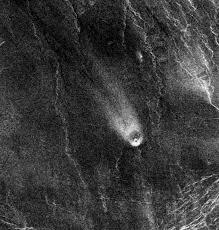
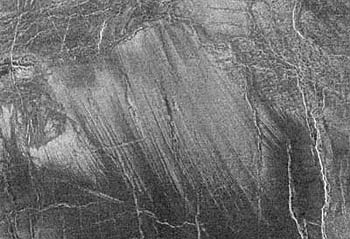
These characteristics leave us with several ambiguities regarding the origin of specific wind streaks, but they are the same ambiguities we faced in interpreting the origin of streaks on Mars. Namely, are the streaks erosional features or depositional features? In general, streaks can be caused by both processes. For example, erosion behind a turbulence enhancing crater or volcanic cone could strip away rough materials to reveal an underlying rock layer with a smooth, radar dark surface. Alternatively, erosion of a smooth blanket of weak, smooth sediment could reveal a rough (radar bright) surface beneath it. In addition, deposition of a smooth patch of dust in a wind shadow would likewise create a radar dark streak. Nonetheless, the streaks show the activity of the wind. Because the streaks are effectively local wind vanes, they reveal the dominant wind directions which can in turn be tied to the global circulation pattern of the atmosphere and the climate. They show that small particles are produced and transported. Thus, streaks, are important, because they show that some process of physical or chemical weathering occurs on Venus to create the small particles. Most fine particles are probably created by impact processes. Some of the winds that created the streaks may also be in response to the explosions or impact of meteorites on to the surface. Atmospheric blasts set up by inclined impacts may be especially effective at scouring fine particles down wind.
Dunes. Dunes are important because they show that sand, and not just small dust-sized particles, are present. Two small dune fields have been identified thus far on Venus. One field covers an area of over 1000 km2. As seen in Figure 7.15, the crest of the dunes are aligned transverse to the dominant wind direction. Impact or explosive volcanism may have created the sand-sized particles for this dune field.
Some impacts may also create air blasts that make transverse dunes upwind from a crater. Perhaps, the dark haloes that surround some impact craters are dune fields created by impact recovery winds
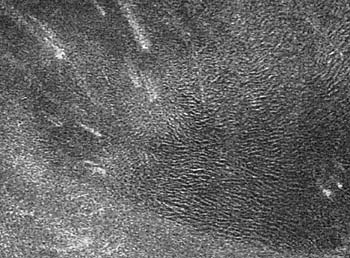
Yardangs. Long ridges carved by wind erosion have been tentatively identified on Venus (Figure 7.14). The impact of wind-born particles on soft sediments can cause erosion of valleys that are parallel to the wind direction. Yardangs are rare on Earth and Mars, but they reveal that wind can be powerful agent of erosion, where soft sediment is exposed to strong winds. A field of about 100 possible yardangs lies near the impact crater Meade. The yardangs here are slightly sinuous parallel ridges separated by narrow grooves. A typical ridge is 25 km long and only 0.5 km wide. The similarity of these ridges to tectonic features makes it difficult to be certain that they are caused by wind erosion.
Venusian Eolian System. The variety of wind-related features on the surface of Venus is similar to those found on other planets and satellites that have atmospheres. The ubiquitous flow of the atmosphere in response to pressure and temperature differences is an important part of the present geologic modification of the surface. This occurs even though the atmosphere of Venus is much denser and very different in composition, as compared to Earth's. The streaks and dunes also attest to the role of physical weathering processes to create small particles. This inference is strengthened by observations made by the landers that photographed the surface of the planet. However, the rate of erosion is quite low on Venus, especially so because it lacks a hydrologic system. As persistent as the wind may be, it is unable to produce the dramatic effects that running water and moving ice wrought on the surfaces of other planets.
Radar images from orbit attest to the effectiveness of some erosive process, probably the wind, in removing the rough, radar-bright, ejecta patterns found around some impact craters. Only the youngest of the Venusian craters possess these bright haloes of ejecta. However, the surface of Venus is not completely covered by eolian sediments. Analysis of the radar data shows that less than one quarter of the surface is covered by unconsolidated soil-like materials.
Weathering processes, wherein atmospheric gases react with rocks to form new minerals stable at the surface, must occur on Venus. We expect weathering on Venus is much different than on Mars or Earth. The main differences result from the absence of water, the extremely high temperature and pressure at the surface, and the composition of the atmosphere. Each of these factors exerts some control on chemical reactions between gas and rock. Minerals that crystallized at high temperatures in lava flows and that are now exposed to CO2 and SO2 gas in the venusian atmosphere are inherently unstable and should decompose to form new minerals. The weathered zone probably consists of a mixture of incompletely reacted minerals and newly formed weathering products. The growth of new minerals may destroy the fabric of the original rock and pry grains apart that can then be moved by the wind or gravity. For example, it is predicted that, as weathering decomposes basaltic lavas, iron oxides and sulfur-rich minerals form as iron silicates are destroyed. However, carbonate minerals, which could remove significant amounts of carbon dioxide from the atmosphere, are not stable on the hot, dry surface of Venus.
Weathering rates on Venus are probably quite low because of the lack of liquid water, which on Earth mobilizes many elements. The presence of joints, such as those produced in cooling lava flows, may also aid weathering by allowing atmospheric gases to penetrate a meter or so below the surface. Some of the reactions that could occur on Venus may be capable of weathering rock to a depth of 1 meter over the course of several hundreds of millions of years. This is a slow rate, but weathering of rocks on Venus probably is more important than the action of the wind in modifying the surfaces of the lava flows, impact craters, and volcanoes.
Direct evidence for the action of such weathering processes is meager, but promising indications were found in some radar images. Radar bright areas are common at high elevations on volcanoes and other types of rises. The transition between radar bright and radar dark terranes lies at an elevation of about 3 to 4 km. In some regions, the boundary between these the bright and the dark zones is amazingly consistent and cuts across various types of terranes. In places, the boundary varies by as little as 100 m over hundreds of kilometers. Some scientists have inferred that weathering at high altitude must produce minerals that strongly reflect radar waves. Weathering reactions at lower altitude create different, non-reflective minerals. Why would the weathering process produce different minerals at different altitudes? The explanation lies in the dramatic temperature and pressure variations in the atmosphere. At high altitudes (11 km) on Venus the temperature is as low as 650 K; at low altitudes (-2 km) it may be as high as 750 K. Atmospheric pressure changes as well from as low as 49 bars at high altitudes to as much as 109 bars. The stable mineral assemblage thus changes with altitude because the temperature and pressure change, even if we regard the atmosphere and the unweathered rock types to be uniform (Figure 7.16). One highly reflective mineral is pyrite, an iron sulfide mineral common in ore deposits on Earth and called fool's gold because of its bright yellow color and metallic sheen. Is it possible that weathering has created an thin coating of pyrite crystals across the surfaces of lava flows at high altitudes on Venus? This would be a spectacular site if seen from the ground. To test this hypothesis, thermodynamic calculations can be used to predict what minerals are stable and produced by weathering. They show that the stable minerals at high altitude include pyrite. At low temperature, pyrite is created as iron rich lavas, like basalt, react with the sulfur in the atmosphere. At higher temperatures like those found in the lowlands, magnetite, an iron oxide, is the stable iron mineral in the weathering zone. At low altitudes, sulfur is probably held mainly in a calcium sulfate mineral called anhydrite.
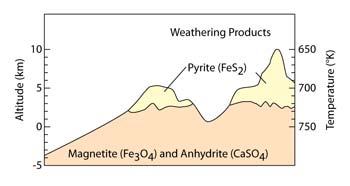
What other processes provide the small particles moved by the wind? Some particles are probably produced by eolian abrasion itself; as particles collide with each other and with the surface, new fragments may be broken from exposed rocks. Locally, tectonic processes such as faulting could also produce small particles by mechanically breaking down larger particles. Other processes that could create fine dust and sand sized particles include explosive volcanism and impact processes. The association of wind-related features to impact craters may indicate that this is the dominant way in which small particles are created on Venus.
Impact craters are ubiquitous on all of the planetary bodies we have examined thus far, from the tiniest asteroid to planets the size of Mars. In addition to being spectacular landforms in their own right, impact craters reveal much about the unique history of each planet. Such is the case on Venus as well.
Close examination of the high-resolution radar images of Venus shows that meteorite impact craters are present (Figure 7.17). Impact craters appear as radar-dark circular features with bright central spots and bright rims (bright areas on radar images correspond to rough surfaces). The planet lacks large tracts of heavily cratered terrain like those found on the Moon, Mercury, and Mars. The entire surface of Venus must have been resurfaced by volcanism and tectonic deformation many times during its long history. In this important way, Venus is more like the Earth than any of the other inner planets.
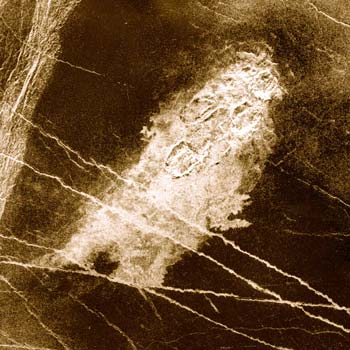
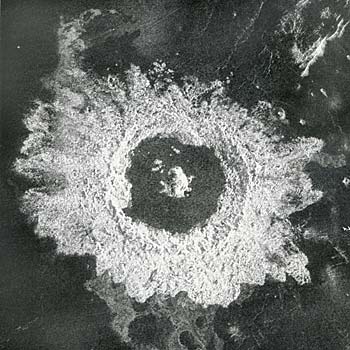
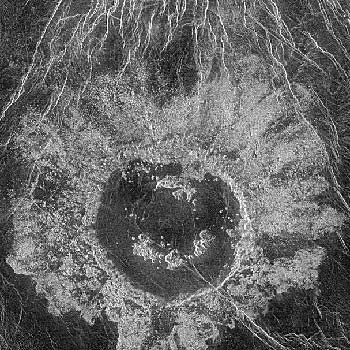
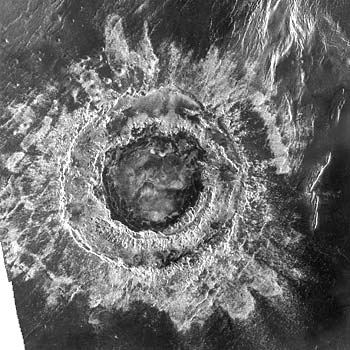
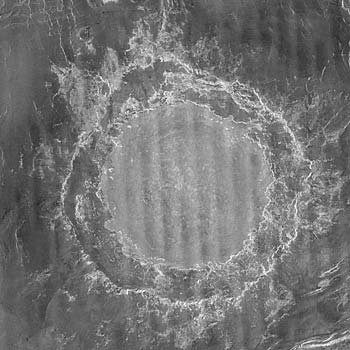
The topographic maps produced from Pioneer Venus radar data were not of high enough resolution to detect impact craters with certainty. Venera spacecraft later explored the northern quarter of the planet and revealed impact features were not abundant. These data were supplemented by Earth-based radar images that confirmed the paucity of impact craters on Venus, but could only resolve craters larger than about 8 km across. Global coverage at sufficient resolution to see essentially all of the planet's impact craters was finally acquired in the opening years of the 1990s by the Magellan spacecraft. These spectacular images show about 1000 impact craters with diameters that range from 1.5 to 280 km across.
In contrast to the Moon and some other inner planets, no striking differences in crater frequencies between different regions were found on Venus. Instead, the craters are fairly evenly distributed across the plains, uplands, and highlands. Moreover, there are no heavily cratered terrains that date back to the time of heavy bombardment in the inner solar system (Figure 7.18). Because the distribution of impact craters is so uniform, all of the craters can be used to calculate an average age for the entire surface of Venus. Using the number of comets and asteroids that presently cross the orbit of Venus, the radiometrically calibrated lunar cratering rate can be adjusted to a value appropriate for Venus. If such estimates of the Venus cratering rate are correct, then the venusian plains are only about 0.5 billion years old. Of course, there is a large uncertainty on this estimate; nonetheless, the real age appears to lie somewhere between 0.7 and 0.2 billions years old. This dramatic conclusion shows that the venusian plains are much younger than the lunar maria, the plains of Mercury, or even the youngest volcanoes on Mars. In fact, the surface of Venus may be almost as young as the vast plains on Earth that we call the sea floor. As discussed in the next chapter, Earth's oceanic crust is less than 0.2 billion years old and, like the venusian plains, is covered by tectonically disrupted basaltic plains.
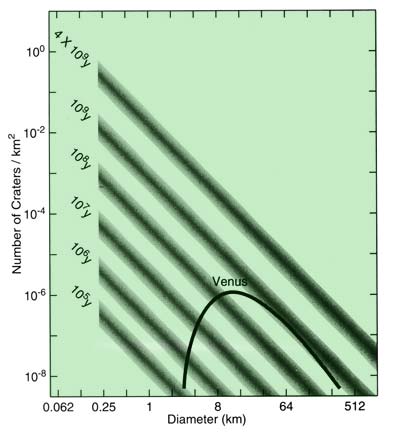
It is important to remember that this estimated age represents the average age of the entire surface and does not exclude the presence of very young surfaces as well. Based on the abundant evidence of volcanic features on Venus that formed the plains and modified the highlands, some Soviet and American geologists believe volcanism is probably still active. In fact, lava flows on one of the high volcanoes on Venus are not radar bright like most high regions. This has been taken as evidence that the lavas are so young that they have not weathered to form the reflective minerals common in high regions elsewhere on Venus.
Venusian impact craters display many of the same changes in shape as lunar craters (Figure 7.17). From largest to smallest, Venusian craters show: multiple outer rings, peak rings, and central peaks and terraces. There are only 6 multiring craters on Venus and all are between 100 and 300 km in diameter. Although smaller, they are similar to multiring basins on Moon, Mercury, and Mars. With the young surface age in mind, it is not surprising to find that Venus has so few large impact craters. There are no large multiring basins like Orientale (900 km in diameter) on the Moon, Caloris (1300 km) on Mercury, or Hellas (2000 km) on Mars, a sure sign that the surface of Venus has been completely made over in the years after the heavy bombardment. Meade, the largest of the craters on Venus, is 280 km across (Figure 7.17). It has a well-defined inner terrace, apparently formed by collapse of the steep wall of the crater immediately after excavation. The crater is less than 2 km deep and has a broad featureless floor. The smooth floor is probably covered by lava the welled up into the center of the crater long after formation. Impact craters larger than about 40 km in diameter have peak rings that rise above relatively flat smooth floors. About 5% of the craters on Venus fall in this category. Craters with central peaks or mounds that rise above broad flat floors are the most common type of crater on Venus, accounting for about 40% of the craters. They are most common for craters between 15 and 35 km in diameter. Wide, terraced walls encircle these craters. Many of them have very smooth, radar-dark floors implying that they were flooded by smooth lava flows. Whether these smooth floors result from the emplacement of impact-generated melt or from eruption of volcanic materials is still controversial. Unlike the Moon, the smallest craters (less than 40 km in diameter) are not simple bowl-shaped craters. These small craters typically are irregular in shape and occur in clusters.
The effect of the dense, hot atmosphere even extends itself into the realm of impact crater morphology on Venus. As noted above, small craters on Venus typically are found in clusters of from 2 to 5 separate depressions. Each crater may have a diameter of 2 to as much as 40 km. The rims of the depressions in these clusters may overlap and the ejecta deposits are irregular and splotchy. These craters seem to be the result of the impact of a group of fragments that struck the surface nearly simultaneously. What is it about Venus that leads to this great difference?
The fragments may have been part of a single larger body the broke apart as it passed through the thick atmosphere of Venus. As a meteor passes through a planet's atmosphere it will heat up as a result of friction with the air molecules. In the dense atmosphere of Venus, heating and expansion are probably dramatic and sufficient to create enough stress to rip the incoming meteor into several fragments that strike the surface simultaneously. Asteroids smaller than about 3 or 4 km across probably cannot survive the trip through the atmosphere of Venus in one piece.
The effects of the dense atmosphere on impact processes reveal themselves in a number of other ways. Perhaps the most striking is the complete absence of craters smaller than 1.5 km in diameter. The radar cameras on Magellan are good enough to see craters as small as a few hundred meters across. The atmosphere of Venus acts as an efficient "filter" and eliminates the smallest meteors before they can hit the ground to form a crater. For example, about 88,000 objects capable of forming a crater as big as Arizona's Meteor Crater (1.2 km across) should have entered the atmosphere of Venus in the last 0.5 billion years. Moreover, all craters smaller than about 35 km in diameter are less abundant than we would predict them to be. The cratering record preserved on the airless Moon shows that the number of smaller impacts greatly exceeds the number of large impacts. We also know that the small asteroids greatly outnumber those that are progressively larger. As a result, we expect the number of impact craters on a planet to progressively increase for smaller and smaller crater diameters (Figure 7.18). On Venus, just the opposite is true, at least for the smaller crater diameters.
Even though an enormous number of asteroids and comets that entered the atmosphere of Venus left no craters, many left some record of the final moments of their histories. Nearly 400 diffuse splotches with no central crater mar the surface of Venus (Figure 7.19). The splotches are from 10 to 70 km across. Haloes, similar to these splotches, surround many legitimate impact craters on Venus and provide the clues necessary to link the splotches with impact processes. Another clue is that some crater clusters include two or three circular dark splotches. The craters were created by fragments that survived transit through the atmosphere and the nearby splotches by fragments of the same meteor that exploded before they hit the surface. These craterless haloes are probably related to pulverization and smoothing of the ground by blasts emanating from meteor fragments that explode in the air. Such an explosion could also generate tremendous blasts of wind that sweep or scour fine particles away from the center of devastation. An air blast with an initial velocity of 360 km/h could surge outward from a body only 300 m across.

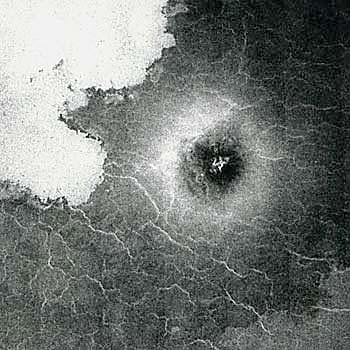
The dramatically different ejecta deposits that surround Venusian craters are another effect of the atmosphere on the impact process. Long irregular tongues of bright materials extend away from the rims of at least 200 craters (Figure 7.20). These are not the symmetrical sort of eject deposits we see around lunar craters, nor are they like the thick lobate splashes of ejecta around many craters on Mars. Rather, in addition to a blanket of hummocky continuous ejecta, there are flows of what appears to be lava away from the central impact site. One crater with a diameter of 90 km has a bright outflow that extends over 600 km from on side of the crater rim. The brightness patterns on the surface of the outflow look just like those on many lava flows. Channels, streamlined islands, tributary and distributary patterns all are visible on these thin deposits. However, these features occur on many types of low viscosity flows including some dry avalanches, mud flows, and pyroclastic flows. The direction of flow is consistently downhill and some flows are block by hills, fractures, or other high obstacles. Larger craters are more likely to have outflow deposits. Moreover, elongated craters made by low-angle impacts have more pronounced outflows. This is surprising in that oblique impacts should produce less impact melt. The outflow is concentrated downrange, that is in the direction parallel to the movement of the impactor. Two, quite different hypotheses have been offered to explain these outflows. Perhaps these outflow are mobilized because they include a larger proportion of impact melt than ejecta on the cooler planets. The second explanations holds that the ejecta in the outflow is a turbulent mixture of solids and hot vapors created during impact and accompanied by entrainment of atmospheric gas. These flows would be much like the huge pyroclastic flows found around some calderas on Earth. Of course, we are not forced to choose between one of these mechanisms; both methods of outflow generation may be operating on Venus.
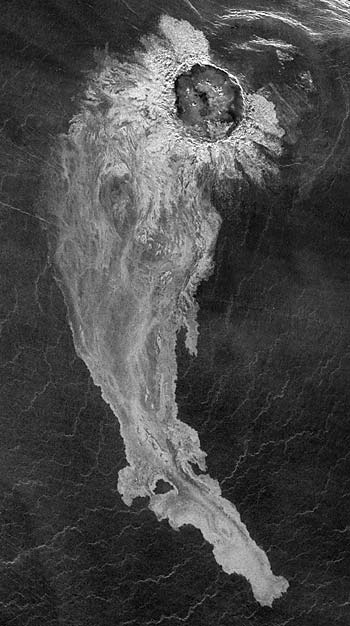
Other young craters are partially surrounded by huge, dark parabolic arcs that open to the west (Figure 7.21). These arcs may be caused when fine material, moved by high altitude winds, settles out after being ejected from the crater. Immediately after impact, all ejecta particles move ballistically through the atmosphere. However, in a planet with an atmosphere, winds force particles to move downwind. The wind affects the smallest particles most strongly and transports them down wind where they eventually fall out in a triangular area with the parent impact crater at one apex. This thin blanket of fine ejecta should be smoother than the surroundings and, therefore, dark in radar images. The wind-blown ejecta may pile up and become thicker on the margins of the parabola.
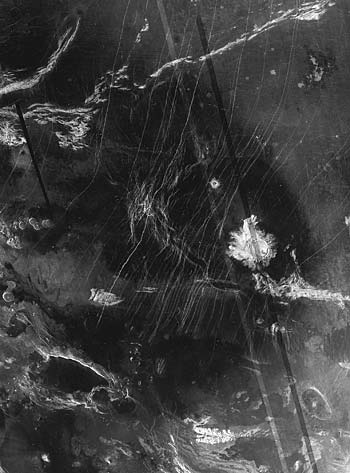
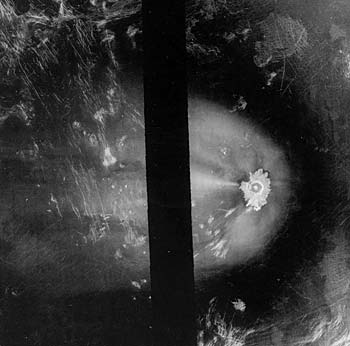
In summary, the atmosphere strongly influenced impact processes on Venus. Large impactors passing through the atmosphere were relatively unaffected and left sizable craters, with dramatic ejecta flow deposits. Intermediate-sized impactors fragmented and produced overlapping or multiple craters, and even smaller ones produced shock-induced splotches but no craters. The smallest projectiles were completely destroyed in the atmosphere and left no traces on the surface.
On most other planets, the age of a crater is directly reflected in its morphology. Crater degradation processes act to progressively modify the crater's ejecta, rim, and floor. Repeated meteorite impact, burial by volcanic flows, tectonic disruption, and erosion by wind and water are the principal mechanisms of degradation. The Moon, Mercury, and Mars show a wide range of craters, from those that are highly degraded and barely discernible to those that are extremely fresh. The range of degradation reflects the range of ages of the craters, with the most degraded craters generally being very old and fresh craters being young.
A striking thing about Venus craters is that most are very fresh. According to one interpretation only a few highly degraded craters exist (Figure 7.22). What are the implications of this conclusion? Some geologists concluded that this means that Venus was completely resurfaced in a single event about 0.5 billion years ago and that little resurfacing has taken place since (Figure 7.23). In this scenario the resurfacing event was short, perhaps even catastrophic. Other geologists looking at the same planet came to a very different conclusion (Figure 7.23). They point out that many of the "pristine" craters actually have smooth, dark floors, indicating that they were partially buried by later lava flows. Likewise, evidence for complex superposition relationships in volcanic terrains, and the variation in the extent of weathering on various lava flows suggest that a range of surface ages does exist on the surface of Venus.
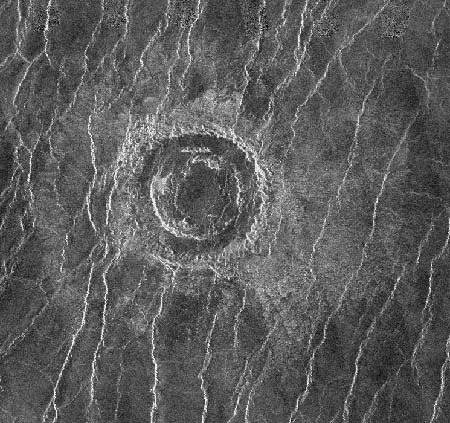
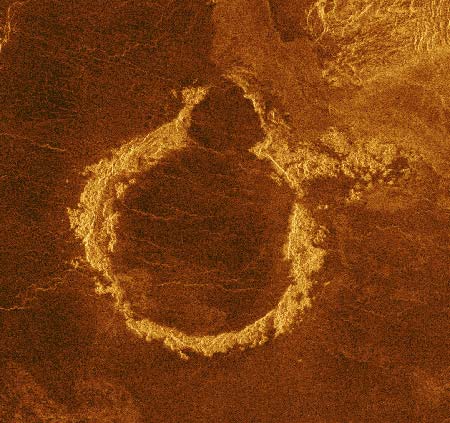
Two decades of exploration of the surface of Venus have shown that a wide variety of tectonic features are ubiquitous on the planet. Venus is not like the slightly deformed Moon. Its surface is strongly deformed at a variety of scales. Its lithosphere has been extended and compressed, domed and depressed. Apparently, deformation has been an important process on Venus for eons and may persist even today, driven by churning of its mantle and gravitational spreading of its highlands. There are several important questions we should ask about the tectonic system. Is the tectonic system on Venus similar to that of Mars, dominated by mantle plumes that create vertical movements of a laterally immobile lithosphere? Or is it Earthlike in character, with plate tectonics and lateral movement of thick plates of lithosphere that produce rifts and folded mountain belts? Or does Venus have a tectonic style of its own?
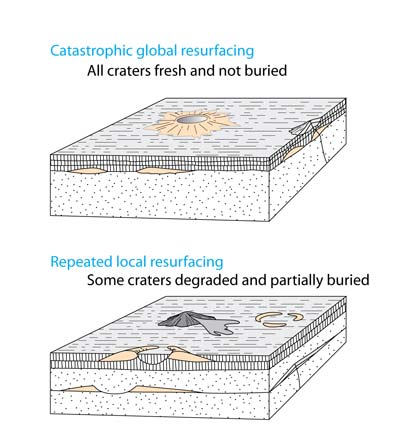
Much of Venus is covered by tectonic landforms that indicate that the lithosphere may be mobile, at least to a limited extent. There are suggestions of tectonic features resulting from doming, extension, and fracturing of the lithosphere. In other areas, large mountain belts and wrinkle ridges suggest compression. These tectonic features occur in many areas, but so far there is no global tectonic pattern that can be discerned. There are no features that can definitely be called subduction trenches, volcanic arcs, or spreading ridges. If present, such features would indicate lithospheric recycling, with production and consumption related to a system of plate tectonics.
Broad crustal domes and rift valleys are common tectonic features on Venus. Beta Regio (Figure 7.24) is a striking example of this association. It is a large domical upland about 2500 km across that is crisscrossed by many faults. The gentle rise is about 4 km high and is crossed by a central trough. A multitude of nearly parallel linear scarps show that the depression is a fault-bounded rift valley, formed as the dome was pulled apart by extension of the lithosphere. The fault scarps are spaced regularly 10 to 20 km apart. The valley has a variable width, like rift valleys on other planets. Called Devana Chasma, this spectacular rift valley has three arms that extend for hundreds of kilometers across the plains to the south, then across the crest of the dome as a series of troughs. The rift is a deep as 6 km in places. A large impact crater, Somerville, is cut by the rift. The crater was originally about 40 km across but rifting has stretched part of it 10 km away (Figure 7.25).
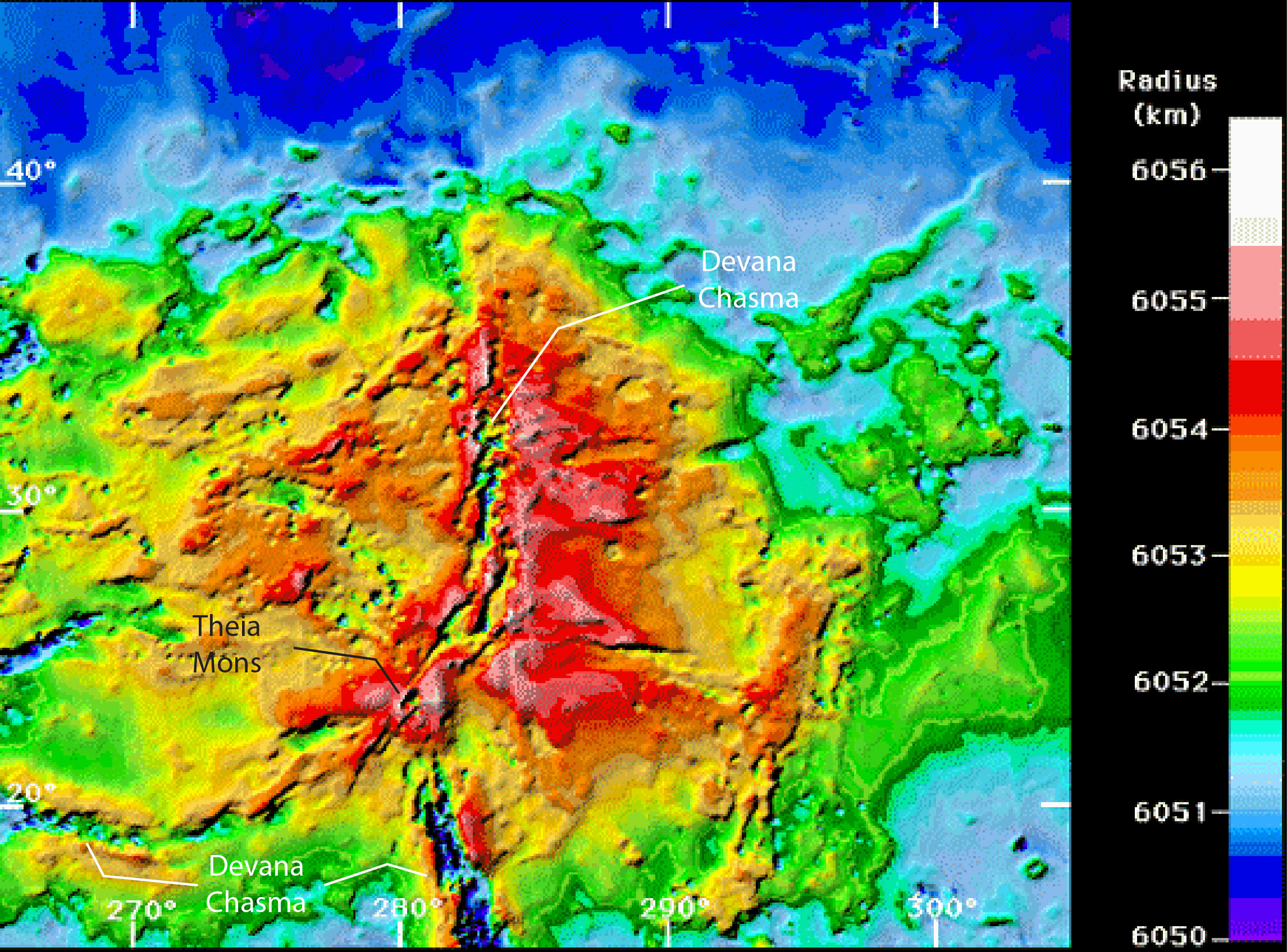
Flanking the southern part of the rift, and partly filling it, is the large shield volcano Theia Mons (Figure 7.24), which rises 4000 meters above the surrounding plains of the western hemisphere. The three arms of Devana Chasma converge on Theia Mons. Radar observations show that Theia Mons has a gently sloping conical shape with a radar-dark circular region near the summit, which is presumably a collapse caldera. The flanks of the volcano are composed of a complex network of overlapping lava flows. Theia Mons is about 350 km in diameter, not quite as large as Olympus Mons on Mars (550 km across). To the north, another large radar bright region is also cut by the rift. Rhea Mons is not a volcano but a region of intense faulting called a tessera. Smooth plains bury some of the fractured region.
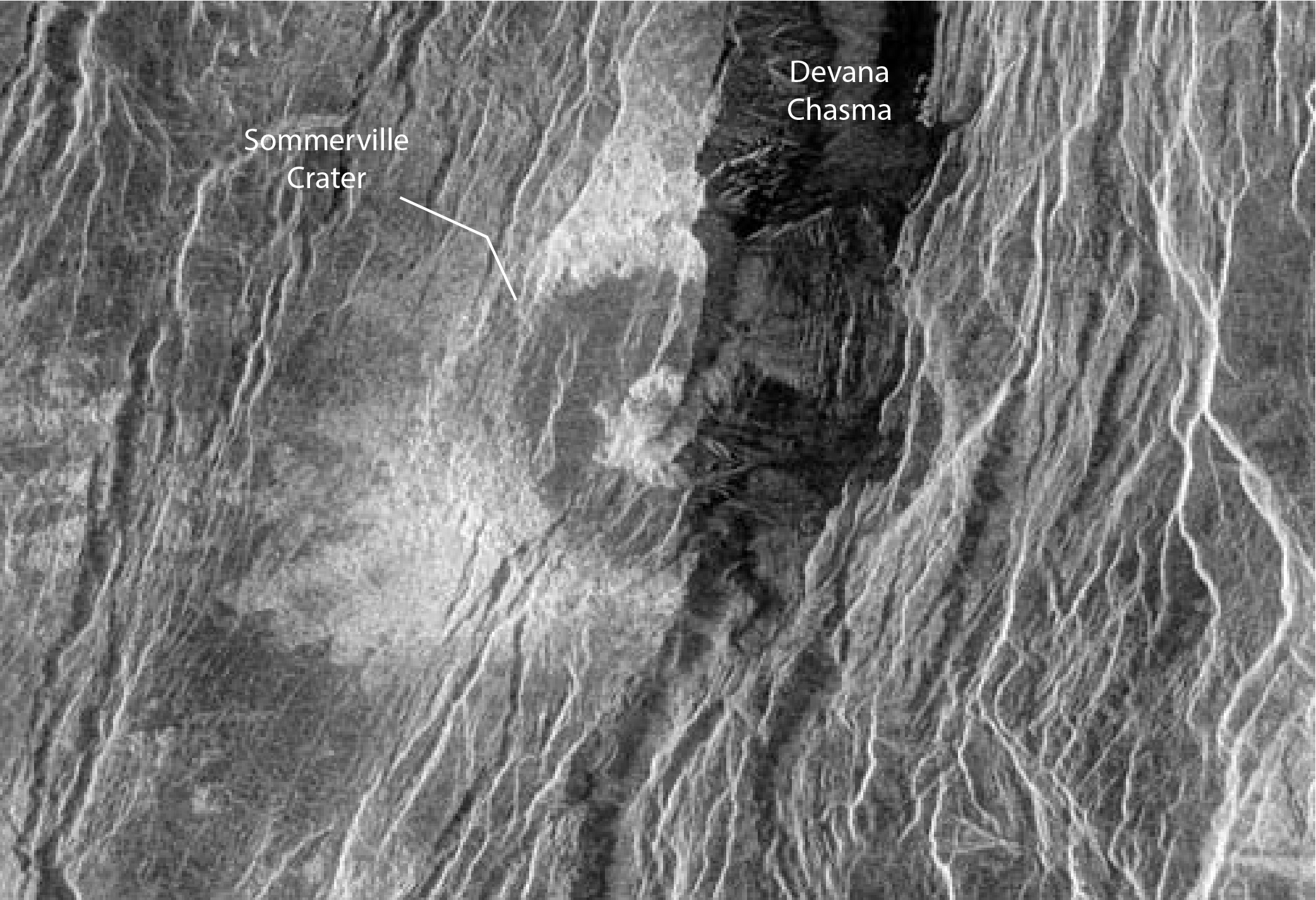
Beta Regio shows many similarities to the Tharsis or Elysium domes and volcanoes on Mars; the Valles Marineris rift cuts the Tharsis rise. Devana Chasma is similar in size and gross morphology to such features as Earth's Red Sea or the East African rift. On Earth, such rift valleys are formed by extensional forces, related to plate movements or to doming caused by upwelling hot mantle. Often, they are bounded by a series of parallel normal faults and are associated with basaltic volcanism. The association of plumes, rifting, and volcanism is common, because the fractures and thin lithosphere found in rifts make it possible for basaltic magma to form in the plume and erupt. The interpretation that the Beta Regio rift is related to basaltic volcanism is supported by information obtained by Venera 9 and 10 which landed just east of Beta Regio. Data sent back from the landers indicate that the rocks in this area have concentrations of radioactive elements similar to those in basalts. Thus, a volcanic origin is suggested by both the nature of the landforms and information about the composition of surface material. Based on its features and comparisons with other planets, Beta Regio must be a region of uplift, rifting, and volcanism that probably overlies upwelling hot mantle material in a mantle plume.
Near Beta Regio, lies another large upland dome called Atla Regio (Figure 7.2). It lies near the equator at the easternmost end of Aphrodite Terra. Like Beta, it rises about 3 km above the lowlands. A complex set of nearly radial fractures is centered on the dome and three large volcanoes, Ozza Mons (4.5 km high), Sapas Mons, and Maat Mons, lie on the crest and flanks of the dome. Other volcanic centers, including several coronas and many small shields and volcanic domes, lie in the same rise. Cross-cutting relationships show that faulting and volcanism were contemporaneous.
Large domes, with associated rifts and volcanoes, occur elsewhere on Venus. Sif and Gula Mons are volcanoes situated on a rise in Western Eistla Regio (Figure 7.26). The large dome is about 3000 km across and reaches and elevation of 1.4 km. Sif is an extensively fractured shield volcano over 100 km in diameter that rises another 2 km above the top of the dome. The summit caldera is about 40 km across and includes several smaller calderas nested within it. Apparently Sif had a long and active history of volcanism and repeated fracturing related to the rise of less dense mantle beneath it. Likewise, Gula Mons has a complex volcanic and tectonic history with multiple volcanic vents. Gula Mons is much higher than Sif Mons and rises 3.2 km above its surroundings. It is the center of a radial set of fractures, suggesting uplift of the dome, but it also sits astride a rift valley. Just north of Gula is a large corona, that rises only 600 m above the flanks of the dome. Like other coronae, it is surrounded by a wreath of grabens sitting within a semi-circular trough. Large lava flows erupted from the troughs. Other large coronae are strung like beads along the eastern extension of the rift through Eistla Regio
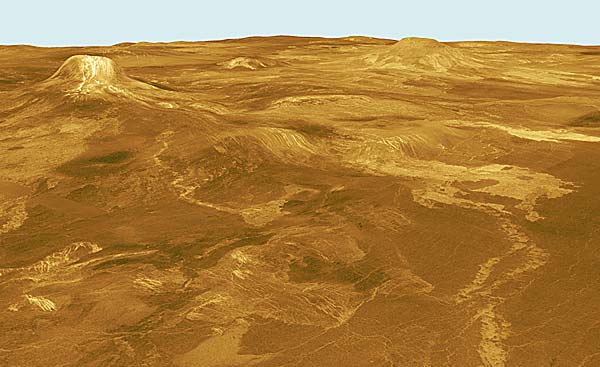
Other riftlike valleys developed in the eastern part of Aphrodite Terra (Figure 7.4). Here the terrain is particularly rough and complex, cut by a number of relatively straight valleys and adjacent high ridges with steep vertical walls nearly 4 km high. Individual valleys can be traced at least 2500 km across the surface. In places, the main valley is 150 km wide and 5 km deep. Like terrestrial rift systems, it branches into two similarly sized depressions. A ridge, very similar to portions of the larger martian canyon, Valles Marineris, runs up the axis of the valley. However, there is no indication that erosion and the removal of material out of the valley system is important on Venus, as is the case for portions of Valles Marineris.
The clear association of lithospheric doming, fracturing or rifting, and volcanism lead us to the conclusion that mantle plumes are common within the interior of Venus. They may be the primary means for Venus to convect and exhaust internal heat. Mantle upwelling on Venus operates on several scales with coronas representing the smaller, short-lived upflows and major volcanic rises representing larger, long-lived convective upwellings. These plumes may be broad upwellings, with individual coronas, novas, arachnoids, and other types of volcano-tectonic centers representing shallow plumes associated with the main upwelling or smaller isolated plumes (Figure 7.27). Because the Venusian lithosphere is not moving across the mantle plumes, the volcanic and tectonic effects of the plumes are concentrated in one area. The volcanoes grow to be larger, the uplifts are higher and broader.

The life history of a plume may proceed something like this. A plume initiates in the deep mantle of Venus and rises because of its low density. As the plume traverses the mantle, it should have a large head and long narrow tail (Figure 7.27A). Partial melting of the plume occurs at shallow depth because of lower pressure. As the partially molten plume head impinges on the base of the lithosphere, it will flatten and create a broad dome in the crust, formed by heat and by the dynamic rise of the plume. The uplift may cause the rigid crust to crack and form radial and concentric fractures or large through-going rifts. As magma from the plume head reaches the surface, volcanoes grow at the surface (Figure 7.27B). Eventually, the plume head looses its thermal energy as it cools and solidifies. At this time, the dome may partially subside because of eruption of voluminous magma from the plume head or by contraction upon cooling. Subsequent volcanism will proceed at a slower rate fed by magma from the still rising plume tail (Figure 7.27C).
Extensional tectonism has produced long belts of deformation marked by abundant fractures and grabens (Figure 7.28). These belts persist over hundreds of kilometers. The grabens are usually narrow, typically less than a kilometer across. Some are so narrow that their floors cannot be seen even at the resolution of the Magellan radar cameras. These are grouped with the fracture belts. The narrowness of the grabens implies a shallow depth of deformation. The amount of stretching indicated by such features is modest, only about 1%. These fracture belts are most common in the uplands and surrounding low-lying plains. The region around Beta Regio and Atla Regio is especially rich in with fracture belts of diverse orientation (Figure 7.29). Because of the extensional nature and abundance in the uplands, it is inferred that they form in response to uplift of the lithosphere over mantle plumes.
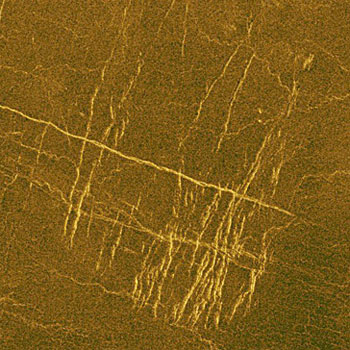
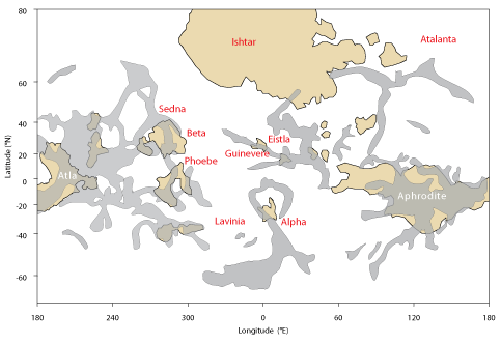
The lowland plains of Venus are crossed by narrow belts of ridges that rise as much as 1 km above the surrounding plains (Figure 7.3). Where they are best displayed in Atalanta Planitia, ridges and valleys alternate with spacings of about 10 km (Figure 7.30). Individual ridges are gently sinuous and appear to braid together with others to form belts 100 to 200 km wide and thousands of kilometers long. Individual ridge belts are separated by expanses of less deformed plains 500 km or so across. These mountains are almost certainly tectonic rather than volcanic features. The ridges are somewhat like the wrinkle ridges of the Moon and Mars or the scarps of Mercury, but they are much more closely spaced and form longer belts. As a result of these differences, the mountain belts of Venus have been variously interpreted as folded mountains, like the Appalachians of North America, or as areas of extensional faulting forming regions like the Basin and Range province on Earth. Several detailed analyses have concluded that the ridge belts of the venusian plains are compressional in nature, partly because of the sinuous, overlapping, and branching character of the ridges. Extension-produced mountain ranges have straighter fronts and do not appear to overlap like these venusian features. Perhaps the ridge belts are folds or stacks of thin sheets bounded by low angle thrust faults (Chapter 6). If so, the ridge belts must be the result of compression of the crust as a result of shortening.
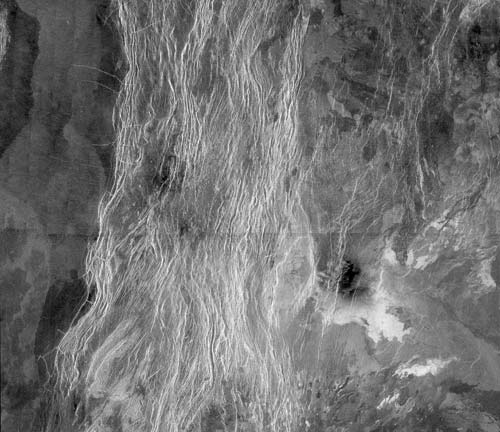
Ridge belts are most common in or near the broad topographic basins in the lowlands (Figure 7.31). Lavinia and Atalanta Planitia are decorated with multiple ridge belts. They are rarely found in regions that have fracture belts. The distribution of the ridge belts and their presumed compressional origin give us a few clues to how they formed. They appear to be formed by large scale down welling in the mantle. Just as there are rising plumes of warm material inferred to be present beneath many topographic rises and volcanic provinces, there must be a pattern of return flow for cool, dense mantle. The large lowland plains of Venus may lie above such "cold spots", cylindrical regions of downward flowing mantle. Mantle downwelling causes the crust to bend downward in much the same way that mantle plumes dynamically uplift the crust. Such a flow field could pull on the overlying crust to crumple it into belts of small folds and thrust faults which we call ridge belts. Subsidence of a region on a sphere decreases its surface area and compressional tectonism is expected.
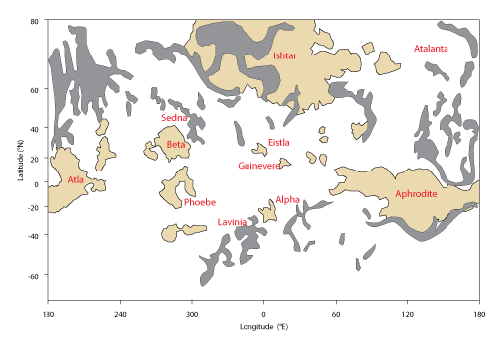
This hypothesis is attractive because: 1) the lowlands are concentrated in circular bowl-shape depressions, corresponding to what we expect to form above a cylindrical sinking flow of cold, dense mantle, 2) no hotspot volcanism, such as shield volcanoes or coronas are seen in the lowlands, 3) no extensional rifts like those on hot spot swells have been identified, and 4) compressional features dominate the plains.
Other strongly deformed terrains consist of densely packed systems of ridges and grooves that criss cross one another and form a disorderly pattern of polygonal blocks (Figure 7.32). These are the tesserae found to cap the highland plateaus and that rim the folded and thrust-faulted mountains of Ishtar Terra at lower elevations. The radar-bright feature called Alpha Regio (Figure 7.2) is an example of this type of highland. Others form the high plateaus of Aphrodite Terra. Magellan data show that these complexly ridged terranes consist of compressional ridges and troughs (folds) upon which are superposed numerous younger grabens. Their appearance and association with mountain belts on Ishtar Terra suggests that these regions were shaped by tectonic forces.
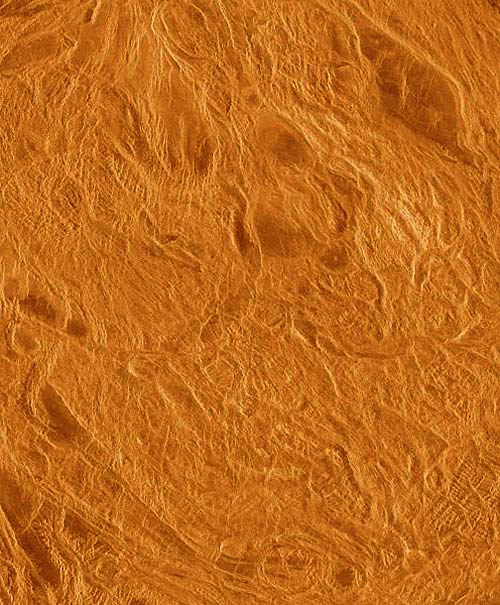
Prior to acquisition of the high-quality images transmitted to Earth by Magellan, some scientists suggested that linear features in Aphrodite Terra were transform faults that cut across the east-west axis of the irregular highland. These same scientists also suggest that the patterns of mountains and valleys are symmetrical north and south of a central high. As a result, they concluded that Aphrodite Terra might be a zone of lithospheric spreading and production of new lithosphere like Earth's divergent mid-ocean ridges. If new lithosphere is produced in Aphrodite, then it must also be consumed somewhere else on the planet. This tantalizing hypothesis was rejected with the new data. No transform fault zones or symmetrical patterns were found in the new images. No subduction zone trenches or volcanic arcs appear on the new radar maps of Venus. Instead, Aphrodite is a string of highland tesserae.
The cause of the deformation within the highland plateaus of Aphrodite and elsewhere is controversial, but the sequence of compression followed by extension implied by their features eliminates some hypotheses and strengthens others. The folds indicate that crustal shortening must be involved; models that involve simple upward movement of the crust are thus unlikely because they predict extension to be the dominant process. One theory is that the tesserae are simply long-lived blocks of thick crust that record a longer history of deformation than the surrounding plains. An elevated terrane is less likely to be buried by volcanic flows and could preserve the changing pattern of regional stress over several billion years. Adjacent lava-covered plains would only record the effects of the last one or two deformation events. Another plausible alternative holds that tesserae are initiated by compression and crustal thickening caused by downwelling of a mantle cold spot (figure 7.33). Mantle downwelling could cause the crust to be deflected downward, forming a more or less circular lowland with compressional ridges and ridge belts. If downwelling continued, the low density crust would buckle and thicken to form an elevated plateau replacing the lowland. During further downwelling, extension and graben formation begin in response to the gravitational failure of the highland. Once downwelling ceases, the high plateau should continue to spread under its own weight at the high temperatures found in the venusian crust.
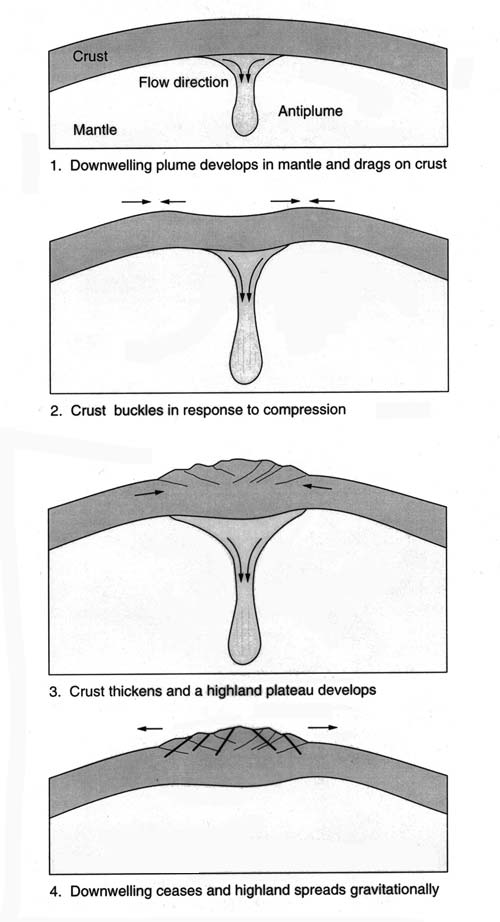
The highlands and plateaus of Ishtar Terra are bounded by long belts of mountains that are similar to, but higher than the ridge belts of the lowland plains (Figure 7.5 and Figure 7.31). These mountain belts represent more extensive deformation and crustal thickening than the ridge belts. The mountain belts of Venus, as on Earth, show widespread evidence for lateral extension both during and following active crustal compression. The deformed areas that border Lakshmi Planum have rugged ridges and valleys that parallel the margin of the plateau but stand 2 or 3 km higher (Figure 7.34). Maxwell Montes of central Ishtar Terra are the highest of these mountain chains, rising 6 kilometers above Lakshmi Planum and up to 12 km above the lowland plains (Figure 7.35). Farther from Lakshmi Planum, the pattern of parallel ridges breaks down, and the mountains consist of intersecting ridges, some even have v-shaped bends, merging with the chaotic fault patterns of the tesserae, described above.
It is unlikely that the ridges and valleys that surround Ishtar were produced by some type of impact or volcanic process. The height and patterns of the ridges imply that they were created by the pileup and warping of the crust as a result of lateral compression. Could it be that they were made by compressional forces as mobile lithospheric plates pressed against one another and eventually buckled into parallel ridges? Probably not, for the parallel mountain belts occur along the entire margin of a highland, not between two colliding blocks of lithosphere. Moreover, no subduction trenches bound Ishtar Terra. Perhaps the ranges are the result of gravitational spreading or slumping of a large block or mountain, as suggested for other highland plateaus on Venus. The high temperatures at the surface of Venus may accentuate this type of deformation by enhancing lateral flow across the surface. The high plateau at Ishtar may have originally formed as a tectonic convergence zone marked by subsidence and crustal thickening over a center of downwelling in the mantle. Such a model may also explain the presence of the two calderas and smooth volcanic plains on Lakshmi Planum that make it different from other tessera plateaus. Crustal thickening may have occurred to the extent that the temperature in the crust became high enough to cause it to partially melt. This magma may have risen buoyantly and accumulated beneath the large calderas where it was periodically erupted to make the smooth plains. Such crustal partial melts may be broadly granitic in composition. Perhaps Ishtar Terra represents a feature similar to those volcanic welts speculated to have formed on ancient Earth, which by their subsidence and basal melting led to the development of granitic continents on Earth.
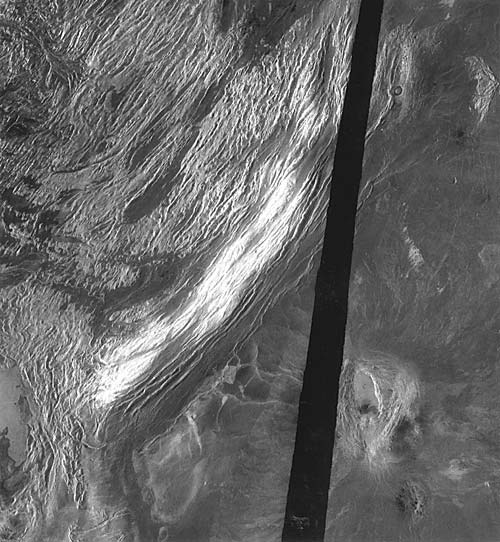
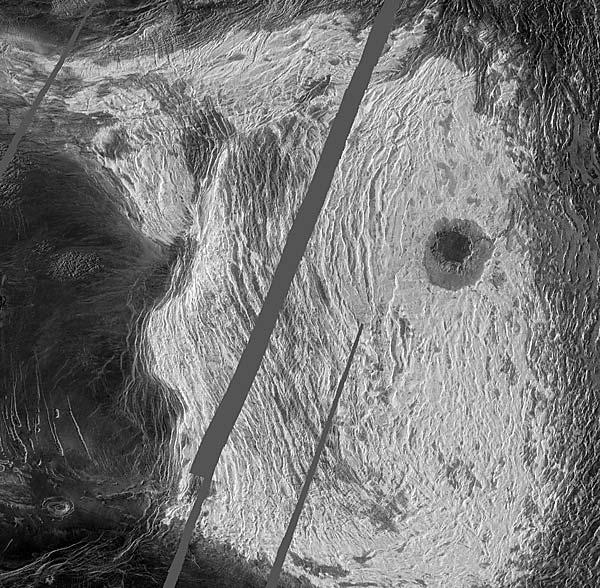
Even after analysis of the thousands of spectacular images returned by the Magellan mission, it is still impossible to provide a conclusive integration of all of its tectonic features. But we can make some conclusions and some reasonable speculations about the global tectonics of Venus. We realize now that a variety of tectonic landforms exist, some like those on Earth and Mars, and some distinctive of only Venus. Its crust is more mobile and deformed than that of Mars, but no compelling evidence for a terrestrial-style plate tectonic system has yet been found on Venus. Crustal shortening or extension of several percent seem to be demanded by the mountain belts and rifts. Volcanism has been voluminous and diverse.
Most of these features can be explained by appealing to a fairly simple mode of mantle convection dominated by plumes counter plumes. Upwellings underlie the rifted, volcano-capped domes and regions rich in volcanic features (Figure 7.27). Mantle downwellings underlie the lowland plains and the deformed highland plateaus, where crustal thickening has been caused by extreme downwelling (Figure 7.33).
The presence and age of volcanic landforms are key indicators of the evolution and internal differentiation of planetary bodies. The Magellan radar images show that there are thousands of large and small volcanoes on Venus and that as much as 80% of the surface is covered by volcanic deposits. Moreover, as noted above, this volcanic terrain was formed much later than the period of heavy bombardment that shaped most of the surfaces of the Moon, Mercury, and Mars.
The most common volcanic deposits on Venus are: shield volcanoes, calderas, flows of flood lava, steep-sided lava domes, sinuous lava channels, and coronas (distinctive volcano tectonic features found only on Venus).
The most common volcanoes on Venus are small shield volcanoes less than 20 km across, formed by the eruption of fluid lava (Figure 7.36). There are probably 10s of thousands of these features on the planet. Many occur in clusters several hundred kilometers across and others occur on the flanks of larger shield volcanoes and associated with coronas. These small volcanoes commonly have small collapse pits at their summits. Some of the fields of shields are centered on longer fractures that may form part of their magmatic plumbing system. A few fields form the focus of extensive lava flows. They are similar to the plains-style volcanism typified by small, low, shield volcanoes and intervening plains, found on the other inner planets.
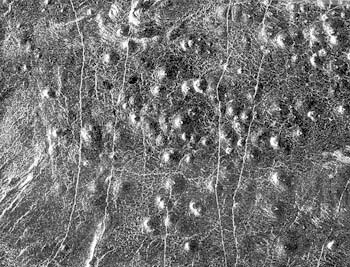
About 500 more or less isolated volcanoes larger than 20 km in diameter have also been identified. Theia Mons on Beta Regio (Figure 7.4) is a good example. Individual volcanoes are as large as 1000 km across, much larger than any volcano on Earth and even larger than Olympus Mons, the largest volcano on Mars. They show a variety of features that demonstrate that they are volcanoes, including radial lava flows and summit calderas. Individual lava flows were fed from central vents or from vents on the flanks of the volcanoes. The sloping sides of some of these volcanoes have collapsed to form debris flows and scallops on the outline of the volcano.
The larger volcanoes in this category are dominated by complex multiple vent volcanic centers which accumulate into large shield like edifices. However, a few are relatively simple shields, with calderas, radial and concentric fractures, and many of the characteristics of the large shields in the Tharsis region of Mars (Figure 7.37). There is a transition between some of the large shields and the coronas, described below.
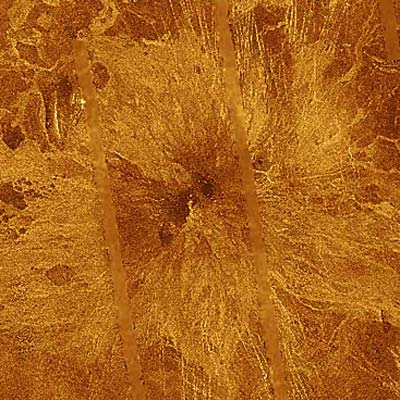
Large volcanoes are almost totally absent from the tessera terranes and are sparsely scattered in the lowland plains. Plains with abundant ridge belts also lack large shield volcanoes, even partially buried shields. The large shields are concentrated in the fractured region centered on the broad topographic rises of Beta and Atla Regio. This is the same pattern displayed by the distribution of the small shield volcanoes.
Dotting the uplands of Venus are several hundred fascinating ring features called coronas (Figure 7.38). A corona is a system of concentric fractures and ridges surrounding a central plain. In some ways a corona resembles a mountain belt that wraps around to form a circle. The rugged mountainous ring is usually higher than the surrounding plains. Fractures with other orientations are also common (Figure 7.38), but they are not as abundant as in the tesserae described below. In most cases, the wreath of deformed terrane has been pulled apart by extension to create grabens and horsts, but in some cases broadly sinuous ridges and warps cross cut earlier formed graben. These are probably wrinkle ridges and folds formed by compression. Volcanic features are commonly located in and near the coronas. Small volcanic shields, lava domes, massive flood lavas, lava channels, and small collapse calderas commonly mark the interior and exterior flanks of a corona. A typical corona has a diameter of about 250 km, but they range in size from less than 100 km to more than 1000 km across.
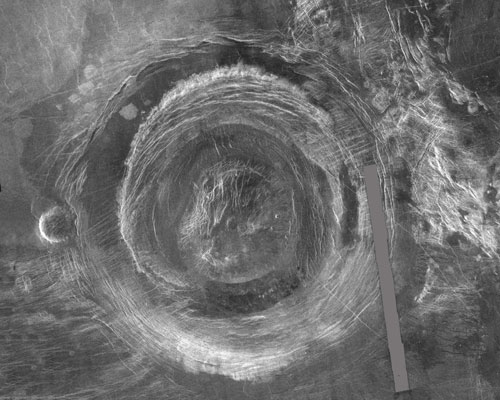
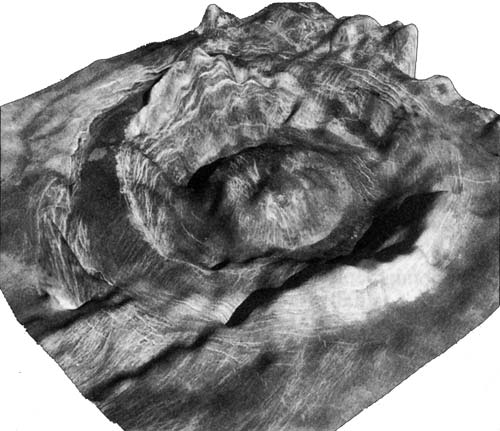

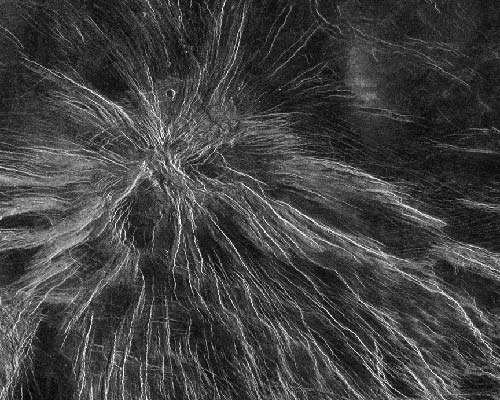
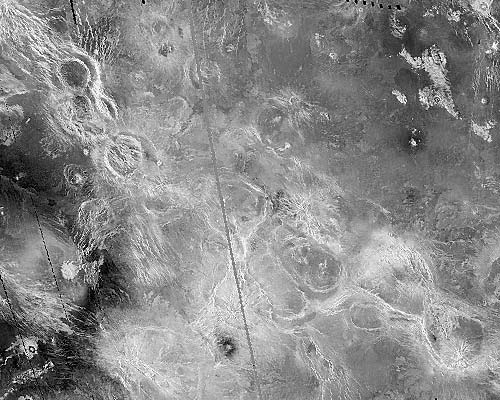
Coronas are widely distributed across Venus and are among the dominant volcanic landforms. About 400 have been identified; many more are partially buried by lava flows or otherwise degraded. Most coronas lie in an area of lithospheric domes and rifting centered on the equator near the Atla-Beta region. There are markedly fewer coronas in the lowlands, such as Atalanta, Guinevere, and Lavinia planitia, than in the uplands or highlands. Many other coronas lie in chains along fracture belts.
Other volcano-tectonic features have many of the characteristics of coronas. Arachnoids have a radial set of fractures superimposed on the concentric set giving them their spider-like appearance (Figure 7.38). The "legs" typically merge with regional fracture belts. Their overall appearance is that of multi-legged spiders sitting on webs of interconnected fractures. Novae have prominent radial fracture patterns leaving starburst patterns on the radar images (Figure 7.38). They lack the wreath of grabens that surround a typical corona. A small central caldera may cap the broad dome. Novae and arachnoids are typically smaller and less abundant than corona
The origins of coronas, arachnoids, and novae are probably similar, differing only in the style of fracturing, an indication of differences in their uplift histories. The evolution of coronas can be related to three general stages (Figure 7.39). The earliest phase includes uplift, radial fracturing, and volcanism. Radial fracturing accompanies domical uplift over buoyant plumes or hot spots in the mantle of Venus. Their features suggest that hot, low density material rose up from the interior and caused the surface to deform and fracture as a result of uplift. Magma was extracted from the plume by partial melting and fed the volcanic edifices and floods that typify many coronas. The second stage involves the flattening of the plume head as it is forced against the base of the strong, but relatively thin, lithosphere. The plume-head takes on a pancake like shape and a broad circular plateau is created. Concentric faults will be produced along the flanks of the plateau and cross cut the earlier radial faults. The concentric fractures around coronas are the result of extension, probably related to downwarping of the moat and upwarping of a raised rim. Depressed moats and raised rims can form through the cooling and gravitational relaxation of a circular plateau that was raised and supported by buoyancy from its high temperature. As the lithosphere bends, grabens can form on the floor of the moat and on up the rim to its crest. Pressure-release melting and volcanism will continue through this stage. The third stage is marked by modification of the dome and includes relaxation, more concentric fracturing, and waning volcanism. Relaxation of a corona involves spreading out under its own weight on the hot surface of Venus creating compressional belts of sinuous ridges along its outer margins.
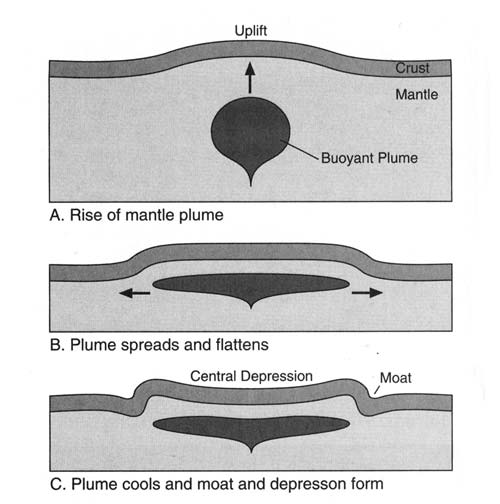
Coronas in all stages of development are found on the surface (Figure 7.38), implying that a sequence of ages of coronas exists. However, it is difficult to independently assign ages to the coronas. Only a few have superimposed impact craters. The only general conclusion we can make about their age is that they are about the same age or younger than the average age of the venusian surface.
Some large shield volcanoes are so low that it is difficult to see the edifice at all. There presence, however, is unmistakable because they are marked by large calderas (Figure 7.40). All are thought to have been created by the withdrawal of magma from huge magma chambers by eruption or drainage. These calderas range up to about 200 km across, but most are only 40 to 80 km across. Although not concentrated in the highlands, two of the best examples of this type of volcano lie on the highland Ishtar Terra. These calderas, Sacajewea and Colette (Figure 7.40), are similar in shape, if not in composition, to the large calderas on Earth from which 1000's of cubic kilometers of rhyolitic ash flows erupted. Examples include the Valles caldera in the Jemez Mountains of New Mexico and the caldera complex in Yellowstone National Park.
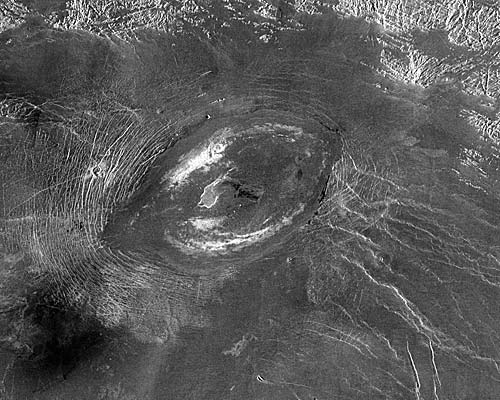
Collette caldera is 1 to 3 km deep and is defined by an inner and outer set of arcuate faults that probably formed as the roof of the volcano collapsed when magma within it was withdrawn. The outer ring is about 200 km across in its longest dimension. Surrounding the caldera are long narrow flows of varying brightness that must be volcanic flows of some sort. The flows appear to bury tectonically disrupted areas to the west, but they are older than the folded mountains on the northwest. Another large caldera, Sacajewea, is present in eastern Lakshmi Planum (Figure 7.5). Together these calderas may be the source of the smooth volcanic plains that cover the plateau.
Nothing in the features of these volcanoes proves that silica-rich ash flows did not erupt from them, but explosive eruptions on Venus are less likely than on Earth because of the high atmospheric pressure. In the venusian atmosphere, expanding gas bubbles that power explosive eruptions would have difficulty forming and explosively expanding to form volcanic ash. Moreover, there is still little evidence for silica-rich magmas on Venus.
Another class of volcanoes have been descriptively called pancake domes, because of their distinctive shapes with steep margins and relatively flat tops. Figure 7.41 shows the characteristics of these distinctive landforms. Some have very small pits at their summits that could be small collapse pits or explosion craters. Because of their similarity to lava domes on Earth, we think these features are produced by the extrusion of viscous lavas from central vents. Radial and concentric fractures cut the surfaces of most of these low domes. Fracturing of the cool, solid rind of a flow as more lava is pumped into the interior could easily explain these features. Many of the domes are aligned in rows on the flanks of larger volcanoes and coronas, suggesting that they are fed by dikes. An important difference between terrestrial lava domes lies in the large size of the venusian domes. Most of these steep-sided domes are about 500 m high and they range from less than 10 to more than 100 km across. Their volumes may thus be in excess of 100 km3. Rhyolite domes on Earth are typically less that 1 km across and include only a fraction of 1 km3 of lava. Moreover, the great regularity in shape of the pancake domes is not typical of most rhyolite domes on Earth, especially the larger ones. As shown in chapter 8, most of the terrestrial domes have short, stubby flows that emanate from one side destroying the initially circular outline imposed by the pipe-like vent.
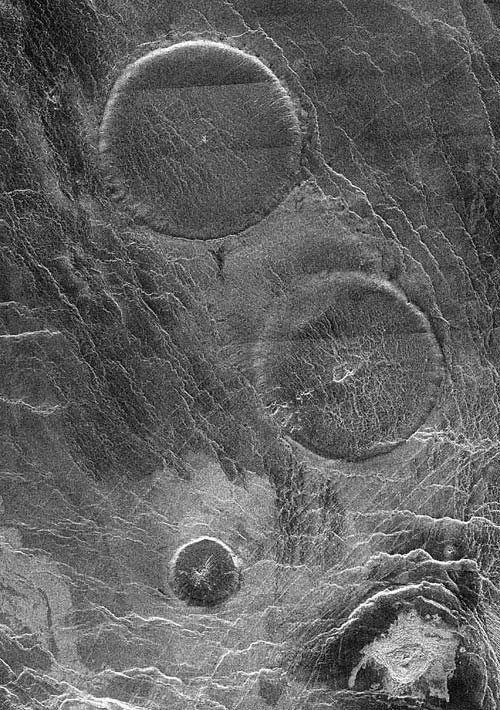
On Earth grossly similar lava domes are produced only by viscous silica-rich lava like rhyolite or dacite (Chapter 2). Basalt is not known to form such domes. Does this mean that granitic magma is produced on Venus? Has the crystallization of mafic magma led to silica-rich compositions? Has partial melting of pre-existing crust produced viscous silicic magma? Only new space probes armed with sophisticated analytical equipment will be able to answer these questions with certainty, but for now there is a hint that at least small volumes of granitic magma are produced on Venus.
Smooth plains are common on Venus and most of these were probably produced by eruptions of flood-type lavas like those that formed the lunar maria and other large smooth plains provinces on the planets. Over 80% of the surface of Venus may be covered by volcanic plains. The formation of small shields and eruption of huge lava floods is the predominant means of producing them. Many of the plains have been subsequently degraded, by other processes including weathering and tectonic processes, so that flow features are not visible on all of them.
Large fields of lava are obvious in many areas of Venus (Figure 7.42). Individual flows are as long as 1000 km. Some show clearly that they erupted from fissure vents, now apparent as graben and faults parallel to regional zones of rifting.) Lava channels occur in the interior of many of these flows. Individual fields typically cover areas of 200,000 km2 or less, and would bury any impact crater in their path. Such flows must play a major role in resurfacing the planet. Such long flows are probably the result of the eruption of very fluid lavas with high eruption rates. The lavas are probably basaltic in composition; Venera landers found the soils had basaltic compositions in the few areas where they landed.
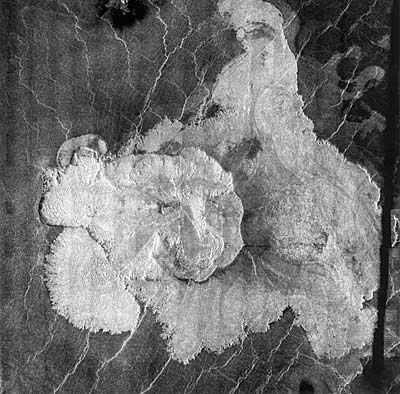
One of the surprises of the Magellan mission was the discovery of hundreds of channels shaped by the flow of a fluid (Figure 7.43). Long sinuous channels trace across many of the plains of Venus. Some are clearly related to the emplacement of long lava flows, because they lie on radar-bright, lobate flows that are hundreds of kilometers long. Many other channels lack obvious lava flows and resemble the sinuous rilles on the Moon. These channels, like terrestrial rivers and lunar sinuous rilles, are erosional features and were carved into the plains across which they extend. Most of the channels consist of a single channel all less than about 2 km wide, but some have complex braided, tributary, or distributary patterns as much as 30 km across. Like sinuous rilles on the Moon, the width of the channels decreases from source to terminus. Delta like distributaries mark the ends of some channels where they empty onto plains. The most spectacular channel is 6800 km long. On Earth, if a channel that long emanated from Kilaeua volcano on the island Hawaii it would reach the Mississippi River in the central United States. This huge lava channels is as long as the Nile, Earth's longest river.
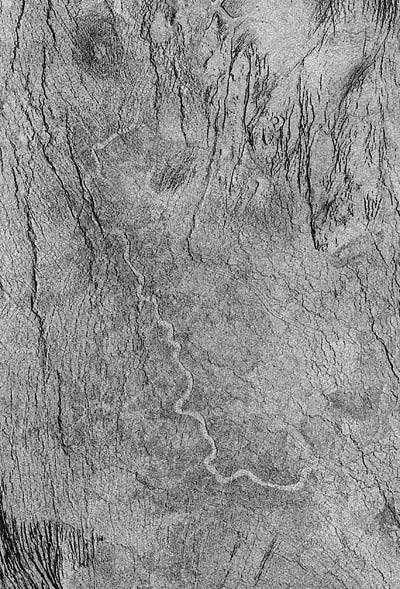
The lava channels occur predominantly in the lowlands and on the flanks of Aphrodite Terra. Where flow directions can be determined, most channels are oriented downslope. Subsequent gentle folding has changed some slopes. Many start in coronas, large irregular volcanic craters, and other volcanic terranes of the uplands and drain into the lowlands. The emplacement of lava from such long channels may be an important mechanism of plains creation. Volcanic vents are rare in the lowland plains.
What type of fluid eroded these channels? Certainly, the high surface temperatures and lack of atmospheric water preclude river erosion. Volcanic fluids as exotic as sulfur, carbonate, and ultramafic silicate magmas are possible. However, arguing only from the abundance of basalt on the terrestrial planets and the rarity of the other materials, basaltic lava is the most likely fluid. Huge eruption rates and the slow cooling at the hot venusian surface would aid in producing long lava channels.
Magma generation and the distribution of volcanoes on Earth are controlled by the plate tectonic system. Notable for their absence on Venus are chains of stratovolcanoes aligned along deep trenches. Moreover, there are no linear chains of shield volcanoes, like the sea mounts produced on moving lithospheric plates above mantle plumes. These types of volcanic systems are the result of moving plates on Earth, and their absence on Venus is strong evidence against an active system of plate tectonics. Can hot spot tectonics explain the nature of volcanic systems on Venus, as they explain many of its tectonic features?

The wide distribution, abundance, and sizes of the various volcanoes and volcanic fields on Venus strongly suggest that they are the surface manifestations of mantle plumes or hot spots and that the different types of volcanoes represent variations in the size of the plume, the stage of its evolution, and the structure of the lithosphere (Figure 7.44). Why do shield fields form in some areas and large shield volcanoes in others? Is it related to the size of the underlying mantle plume? It is reasonable to suggest that the progression from small shields to shield fields to large shield volcanoes forms a continuum reflecting the size of the underlying mantle plume. Small plumes may be little more than cylindrical pipes with no enlarged heads. Pressure-release melting in such a rising plume could feed small volcanoes. Large plumes might feed multiple volcanic systems as separate magma bodies separate out from the enlarged head of a starter plume, feeding multiple shield fields or the huge volcanoes that cap lithospheric domes.
Volcanic features on Venus are broadly distributed, in contrast to the strong concentration of volcanoes along linear plate boundaries on Earth (Figure 7.45). There is no equivalent of Earth's Ring of Fire on Venus. The distribution of volcanoes on Venus is, therefore, much more like the distribution of hot spots on Earth. Only about 100 hot spots are believed to have been active in the last 70 million years on Earth. Of course Venus has many more large volcanic centers than this. If Earth dynamics minus plate tectonics tell us anything about Venus dynamics, we might expect about 700 major hot spots on Venus to have developed over the last 500 million years. The lack of crustal recycling and the low rates of erosion on Venus mean that even the oldest of the hotspot volcanoes would still be visible. Approximately 700 large volcanoes, calderas, lava floods, and coronas and related features have been counted on Venus. Another 500 or so fields of shield volcanoes have also been identified. Thus the number of hot spots predicted by comparison to Earth is about the same as the observed number of large hot spot volcanic centers on Venus.
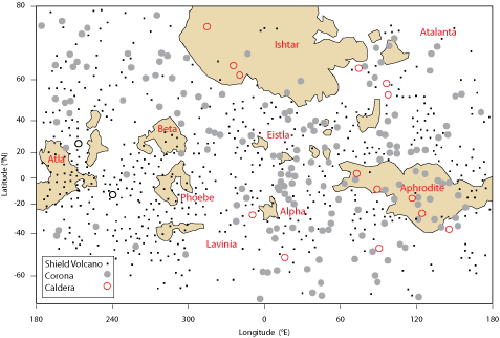
However, volcanoes are not randomly distributed on Venus. There are few volcanoes in the lowland areas of Venus. Likewise, the major highlands, Aphrodite and Ishtar Terra have relatively few volcanoes. There is a major concentration of volcanic features in the equatorial region centered on the lithospheric domes at Beta and Atla (Figure 7.45). This region also has many fracture zones, rifts, and several lithospheric domes capped by volcanoes. Estimates of the rate of lava production on Venus are still very crude, but range from 0.5 to 1 km3 per year, averaged over the last 0.5 billion years. This is much lower than the rate of volcanism at Earth's mid-ocean spreading ridges or at convergent plate boundaries, but it is similar to that for intraplate volcanoes related to mantle plumes (0.3 to 0.5 km3/year). This gives further credence to the idea that much of the volcanism is related to mantle plumes
Most of the volcanic landforms are consistent with basaltic magma compositions. According to the partial analyses made so far by Soviet landers, the surface soils are quite similar to basalt, that is, igneous rocks that are rich in magnesium, iron, and calcium, like those found on the maria of the Moon, the volcanoes of Mars, some asteroids, and in many environments on Earth where partial melts of the mantle can rise to the surface.
The low number of impact craters on Venus shows that it has a young surface. The average age of the entire surface is about 0.5 billion years old. One possible interpretation of the history of Venus calls for a remarkable, perhaps even catastrophic, global resurfacing event that ended 0.5 billion years ago. Little deformation or volcanism has occurred since this time. Purportedly, the volcanic coronas, long lava floods, and highly deformed highlands are remnants of this global event. In essence, we are looking at a fossil surface where little change has gone on for 0.5 billion years. Support for this idea lies in the very uniform distribution of impact craters across the surface. If large areas were resurfaced any time between about 0.5 billion years ago and today, large areas without craters should be apparent. These investigators think that as little as 10% of the surface has been resurfaced since this global event by the emplacement of lava flows, formation of fault and fold belts, or by weathering and erosion. Of course, earlier global resurfacing events could have occurred but any evidence for them was destroyed by the latest event.
No other planet shows evidence for similar events in its history. What in the nature of Venus might explain how such an "on or off" history could happen? Some suggest that oscillations of mantle flow set in on a planet such as Venus with high surface temperatures and a weak lithosphere. Because of the periodicity of mantle flow, periodic resurfacing events occur on a global scale. This scenario may even account for the lack of a magnetic field in Venus, because it predicts that the interior cooled more efficiently and the core solidified during the last billion years. According to the model, about 0.5 billion years ago the vigor of convection diminished and a permanent crust developed. At this stage, the tectonic style changed from recycling of crustal plates to hotspot volcanism. The model implies that the interior of Venus is completely solid now, except for small partial molten regions in the upper mantle that feed mantle plumes.
A dramatically different picture emerges from the alternative idea that the surface is being gradually and continuously resurfaced over its long geologic history. In this case, there would be areas with distinct geologic ages. The region of abundant volcanoes and apparent mantle upwelling does indeed appear to have a slightly lower abundance of craters. The complex superposition relationships in the volcanic terrains suggest long periods of volcanism. Variation in the extent of weathering implies a range of ages for lava flows. Moreover, many craters have dark smooth floors, unlike the distinctly fresh craters with parabolic ejecta arcs and bright floors. Perhaps the smooth floors are a sign of degradation and the passage of time.
Those who support this hypothesis conclude that only "small" areas are resurfaced at a time. This process could gradually resurface Venus without making the craters look unevenly distributed. If areas less than 150,000 km2 were covered in each resurfacing "patch" it would not visibly affect the global distribution of the craters; they would still look randomly and uniformly distributed. Few craters would be buried, simply because the craters are so few and far apart. The most obvious way to resurface Venus is by the development of volcanoes and volcanic fields. Many large volcanic fields are associated with shield volcanoes and coronas. Would the development of one corona be apparent in the destruction of impact craters? The answer is probably not. The area covered by a typical corona is only about 50,000 km2, much smaller than the 150,000 km2 limit imposed by the randomly spaced craters. Likewise, other types of large volcanoes and large flood lavas individually cover about 130,000 km2. In short, the likely way to resurface Venus operates on a small enough scale to be invisible with regard to the crater distribution. Therefore, if the volcanic regions are created randomly in space and time, they would not disrupt the apparently uniform distribution of craters.
In this gradualistic model, no global catastrophes are required; no convective overturn is called for. The resulting history implied by this idea is more like that of the Earth or Mars in that the planet was initially hot, cooled slowly because of its large size, retaining enough heat to power active magmatism and tectonism until the present day.
Neither hypothesis readily explains why Venus lacks a system of plate tectonics, but is instead dominated by mantle plumes. The implication is clear; Earth is unique, in that Mars, Earth, and Venus share hot spots and a convective style that includes, even if it is not dominated by, mantle downwellings and upwellings called plumes.
Judging from what we know about its surface features, the flow of energy on and in Venus takes place in a very different manner than on Earth and produces a different set of geologic features. This occurs, in spite of the planets' similar sizes and densities. A profitable way to examine these differences is in terms of the sources of energy that are available to drive geologic processes on Venus. One source of energy is the Sun. On Earth, energy from the Sun and the influence of gravity drives the circulation of the hydrosphere and atmosphere, which may be considered the outermost layers of a differentiated planet. Solar energy arriving at Venus drives a similar convective system in its thick atmosphere. Theoretical calculations, laboratory measurements, and radar images show that measured wind velocities are sufficient to move particles. An eolian regime with transportation and deposition of sedimentary particles exists on Venus. These atmospheric movements, driven by an external energy input, along with the weathering of freshly exposed rocks constitute important, still active, geologic systems on Venus.
Solar energy is also important in other ways. We have seen how heat from the Sun is trapped by the venusian atmosphere to create high surface temperatures. These high temperatures are postulated to have been vital to a mechanism that rid Venus of its water. Once the temperature was sufficiently high, water was in a vapor state, and therefore available for disassociation and loss to space. The lack of water has important consequences for the erosional history of the planet, the rock cycle, and even for the tectonic history of the planet. A few percent of water in a planet's mantle can lower its melting temperature by 200 to 600 K, increase its fluidity, and stretch the duration of periods of mobile tectonics and volcanism.
Another energy source comes from the heat generated within the planet by radioactive decay or retained from the planet's accretion and differentiation. This energy powers the convection of the mantle. In turn, the vigor, style, and pattern of convection control a planet's volcanic and tectonic systems. Plate tectonics, mantle plumes, and hot spots are important patterns of mantle convection on Earth, Venus, and Mars. In an attempt to tie several disparate observations together, a few scientists have suggested that the high surface temperature, the history of water, the patterns of mantle convection, and the volcanic and tectonic history of Venus are closely tied together.
Here we need to reconsider some possibilities for the composition of Venus. However, both major possibilities converge on the same final result. Perhaps, Venus has always been poor in water because of forming so close to the hot sun. Alternatively, the early differentiation of Venus may have expelled its water as vapor to the atmosphere. Eventually, as the surface was warmed by the greenhouse effect, the interior and atmosphere of Venus were purged of water. As a result of either of these scenarios, temperatures in the venusian mantle were far below the point of partial melting. A fluid asthenosphere disappeared early or never existed.
Thus, plate tectonics, which requires a shallow fluid asthenosphere to allow thin slabs of lithosphere to slip around as a result of their own weight, died out early or never developed on Venus. In a water-poor Venus, the role of water as a flux for low temperature magma production would not exist. The generation of light granitic magmas may similarly have been prohibited. Some have suggested that the lithosphere of Venus remained buoyant, unable to recycle itself back into the mantle by moving laterally, because of the high surface temperatures caused by global greenhouse heating. Instead, continued mantle convection favored the production of many mantle plumes. Swells or domes capped by volcanoes grew above the mantle plumes and were rifted by extension. Rising plumes in a convecting mantle may tell only half the story; complementary downflows, or antiplumes, are necessary too. If Venus lacks a shallow asthenosphere, then the effects of these cylindrical or sheetlike downflowing regions will be coupled by viscous drag to the crust (Figure 7.33). Because the crust is part of a spherical shell, as it is dragged downward, compression ensues. The high temperatures on Venus mean that the compressed crust will be weak and deform ductilely. Without much resistance to these compressive forces, the crust should buckle, bend, fold, and eventually thicken. Deep smooth basins crossed by compressional ridge belts, and with few volcanoes, must have formed above the cold spots. Continued contraction created complexly folded high plateaus. Once a plateau became high enough or when convective downwelling stopped, it relaxed and stretched apart under its own weight. Grabens and fractures would then cut across the already folded regions to create tesserae.
Because our knowledge of age relationships is very limited, comparisons with the other planets are useful in formulating a speculative geologic history of Venus. Essential to understanding planetary history is the development of a geologic time scale based on a knowledge of the sequence of events that produced the various features and rock bodies exposed at the surface. On Earth, Mars, Mercury, and the Moon, the principle of superposition has been used to create a stratigraphic or relative time scale. In some cases, radiometric dates and crater frequencies have allowed a more quantitative assessment of the timing of geologic events. Because of the low crater density and lack of radiometric ages, such evaluations are presently difficult. We can paint the geologic history of Venus only with broad, crude brush strokes, by integrating what we know about its surface and employing analogies with the rest of the inner planets, particularly the Moon and Earth.
Like the other terrestrial planets, Venus probably formed in a fairly short time by the accretion of many smaller planetesimals by gravitational capture. The slow retrograde rotation of Venus may be inherited from this time. A large glancing impact late in its accretion history may have reversed the normal spin of the planet, slowing the rate of rotation as well. The infall of accreting material should have caused high internal temperatures (Figure 7.46).
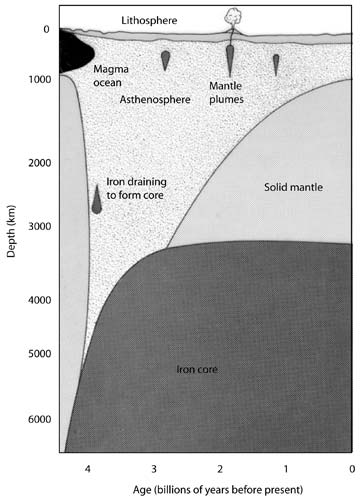
As a result of this accretionary heating and heat produced by the decay of radioactive elements, the interior of the planet differentiated into layers of different composition and density, probably forming a metallic core, and a mantle and crust of silicate minerals. The period of differentiation must have occurred during a period of intense meteoritic bombardment but no tracts of heavily cratered terrain have been preserved. All of the surface of Venus is younger than the period of accretion and differentiation.
The fluid envelope surrounding the planet was released from its interior during differentiation. A carbon dioxide rich atmosphere was created. Here an important mystery remains. Did Venus have water that was expelled or was it always as water-poor as it is today? Anyway, water released to the venusian atmosphere may never have condensed to liquid form because greenhouse heating caused temperatures to exceed the boiling point of water. If a venusian ocean formed, it was boiled off by intense greenhouse heating. Eventually, water vapor was broken down to hydrogen and oxygen. The hydrogen may have escaped into space and the oxygen combined with surface materials leaving the present "dry" atmosphere. With continued outgassing, the interior was also purged of water.
The remainder of geologic history of Venus may have been decided by the rate and manner in which it rid itself of internal heat. The composition and thermal history of a planet are very important to the mechanism and rate of planetary evolution. Calculations imply that Venus, with its Earthlike size, density, and composition, had a thermal history like Earth (Figure 7.46). Earth's most important mode of heat loss is presently the formation and cooling of new oceanic lithosphere. Plate tectonics or substantial lateral movement of the lithosphere of Venus is not indicated. No hot spot trails are apparent. No subduction trenches or parallel chains of volcanoes are present.
Venus must be losing its heat by a different mode---through its hot spots. According to this theory, domes, shield volcanoes, and coronas scattered across the planets overlie warm rising plumes (Figure 7.47). Upon development of a rising plume of low density material, for example, heat flows through the crust and is radiated away to space. If partial melts from the plume penetrate the crust, volcanism may be active atop the domes, which also expels heat from inside the planet.
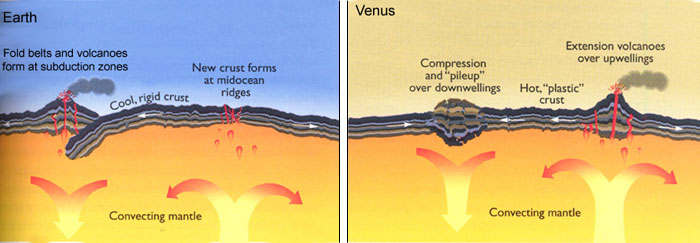
Why would Venus expel its internal heat in such a different manner when compared to Earth? It could be related to the high surface temperatures. On Earth, as newly formed oceanic lithosphere moves away from a spreading ridge, cooling and metamorphic transitions form dense minerals in oceanic lithosphere that act as gravitational "sinkers," driving the terrestrial lithosphere back into the mantle. Cooling and metamorphic reactions that form such dense minerals may never occur in the hotter lithosphere of Venus. Instead, the venusian crust may be only partly recycled into the mantle when the crust thickens by crumpling or becomes deeply buried by recurrent volcanism. Gravity could detach slabs of dense metamorphic minerals formed in the crust back into the mantle. Or basal melting and convection could sweep a small fraction of this crustal material to the mantle, but most should return toward the surface as buoyant magma.
Another possibile explanation for the absence of plate tectonis is that Venus, in spite of its high surface temperatures, lacks a shallow asthenosphere. Its crust may be tightly bound to a stiff upper mantle that prohibits lateral movements and, simultaneously, allows the effects of convective plumes to be impressed directly on the crust. Why would Venus lack an asthenosphere? It could be because the mantle is water-poor and deforms or melts only at higher temperatures than in the wetter Earth.
This scenario could be summarized as--no water, no asthenosphere; no asthenosphere, no plate tectonics. To investigate the likelihood of this speculative history it will be important to better understand the history of water on Venus. Did Venus ever have water? When and how was it lost? Answers to these basic questions may help us to ultimately resolve how the venusian mantle convects and how the evolution of convection styles has affected the geologic history exposed on the surface.
Certainly, tectonics and volcanism are not the only processes to shape the evolution of Venus. Its surface features also continue to evolve as the chemically reactive atmosphere combines with surface rocks and fine particles are produced. Eolian transport of the sediments continues to create streaks, dunes, and yardangs.
As the veil of clouds enveloping the surface of Venus is gradually lifted by the development of new technologies and expanded exploration, we may get new perspectives on the geologic history of Venus, modifying the speculations outlined above. An understanding of the geology of Venus is critically important, because of the contrast it presents with Earth and for the clues it will provide about the origin and evolution of the planets. Earth and Venus are similar in size, composition, and distance from the Sun. Yet they are not identical twins, and have evolved along remarkably different paths. Venus's thick, carbon dioxide atmosphere and high temperature are important differences between Earth and Venus and must have played significant parts in determining the present geology. Perhaps because of its greenhouse climate, Venus lacks water, a hydrologic system, and plate tectonics.
However, Venus is a dynamic planet. Its surface is relatively young; any ancient cratered terrains have been resurfaced by dynamic tectonic and volcanic processes. Tectonic features show that lithospheric extension and compression have shaped the surface. Large and small volcanoes are scattered across the highlands. In some ways Venus is like Earth, with its folded mountain belts, highly deformed, relatively young surface, and abundant volcanism. In other ways, Venus is like the smaller planet Mars, which has a thick lithosphere, crustal domes and rifts caused by hotspots. We do not yet know for certain how Venus loses heat, which in turn governs the style and vigor of its global tectonic system, but hot spot convection seems likely and may provide the key to understanding the volcanic and tectonic evolution of Venus.
Important unresolved questions highlight our present understanding, or lack of understanding, of Venus, the planet next door.
How does the composition of Venus compare with that of the Earth or other inner planets? Is it volatile-poor as a result of forming near the Sun? If not, how and when did water escape from the planet?
What style of tectonics shapes the surface of Venus?
Was granite formed on Venus? Is Ishtar Terra or the pancake domes composed of granitic materials.
Is Venus volcanically active today?